
Nizhny Park is one of the most beautiful and visited parks in St. Petersburg.
The Lower Park is part of the Peterhof Palace and Park Ensemble in Peterhof, which also includes the Grand Peterhof Palace and The Upper Garden, and which together represent a large-scale work of landscape art, architecture, and history.
In the Lower Park of Peterhof located: small palaces and pavilions, which are now museums, sculptures and monuments, Marina, ponds and flower beds, the alley, walking paths and places to stay; and, most importantly, what distinguishes the Lower Park, among other parks of Peterhof and St. Petersburg is the numerous fountains, which is in the Park 30. Since some of the park's fountains are an ensemble of several fountains, the territory of the Lower Park is decorated with a total of about 150 fountains - for this reason, the Lower Park is also known as the"Fountain Park".
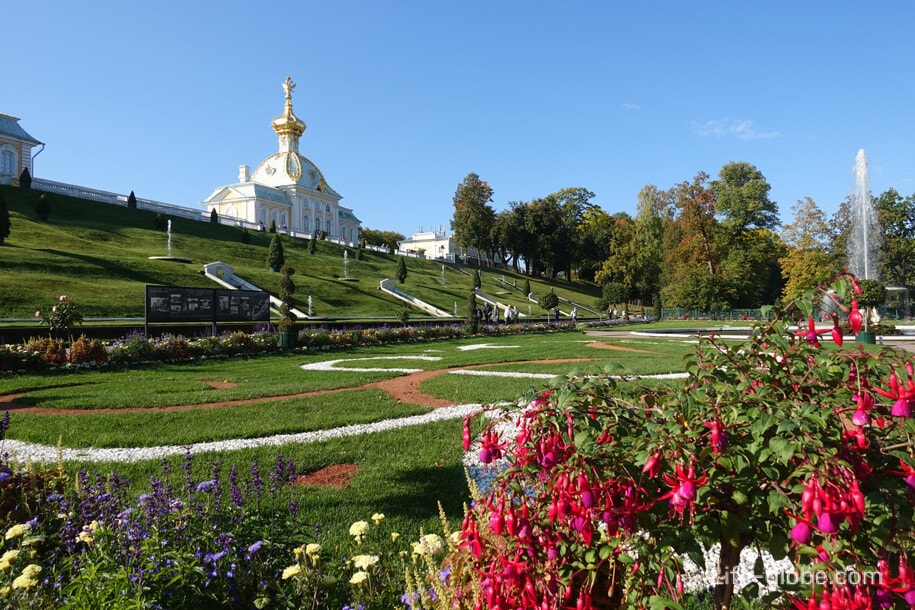
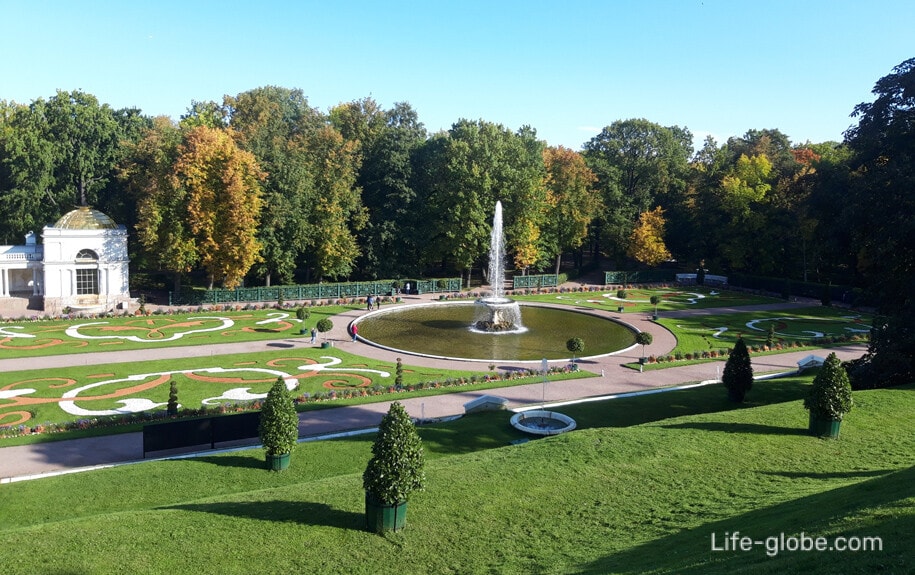
The formation of the Lower Park, as well as the Grand Palace, dates back to the reign of Peter I, according to whose idea, as well as sketches and drawings, the Peterhof palace ensemble was created - the only seaside residence of the Russian emperors.
The formation of the Lower Park took place in 1714 - 1723. Architects of the Lower Park: Johann Friedrich Braunstein, Jean-Baptiste Leblon, N. Michetti, Francesco Bartolomeo Rastrelli, Andrey Nikiforovich Voronikhin, Andrey Ivanovich Stackenschneidero; garden masters: L. Garnichfelt, A. Borisov, B. Fock and T. Timofeev.
During the history, including during the destruction of the Second World War, many decorative elements of the park have disappeared. However, they were later restored according to drawings, photographs and drawings, which allows us to see the architectural and landscape harmony and trace the history of the Lower Park even today.
The Lower Park has an area of 102.5 hectares, the layout of regular parks and is located between the Gulf of Finland and the Great Peterhof Palace, where today you can visit the restored halls of the palace and museums. Learn more about the Grand Peterhof Palace with its halls and museums…
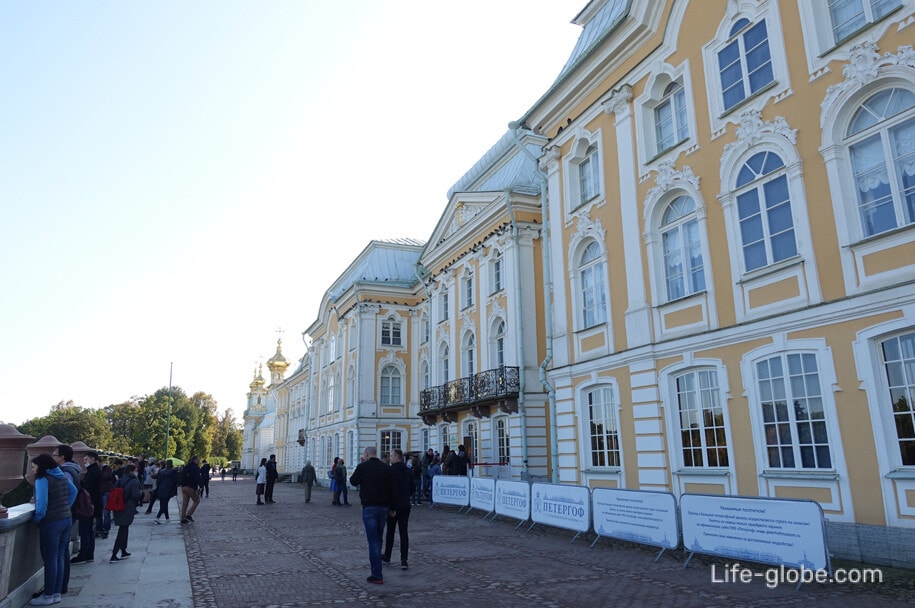
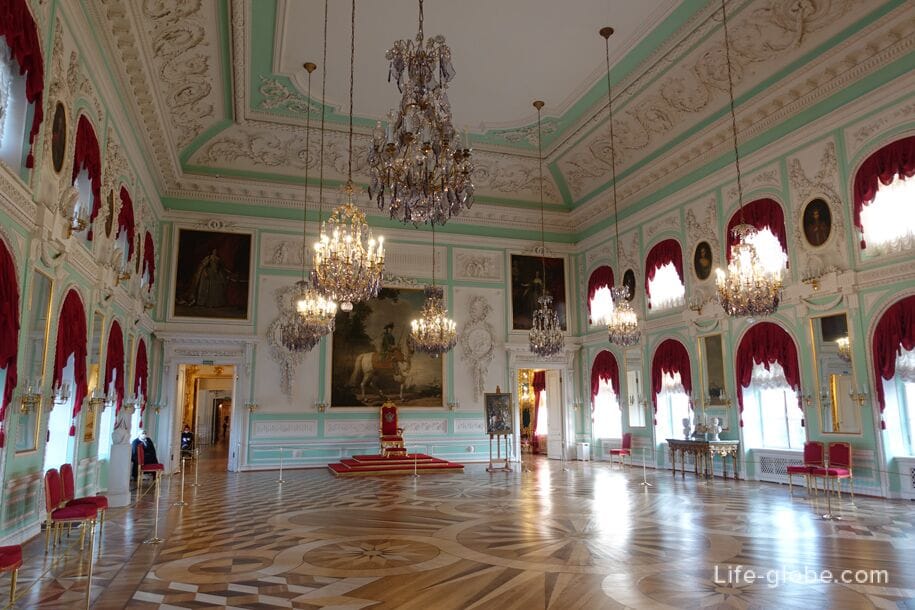
The layout of the Lower Park is defined by two systems of alleys that fan out from the Grand Palace and the Marly Palace. Each of the alleys ends either with a palace, a fountain, or leads to the Gulf of Finland.
Along the alleys are sculptures, recreation areas, ornamental shrubs, trees and flower beds.
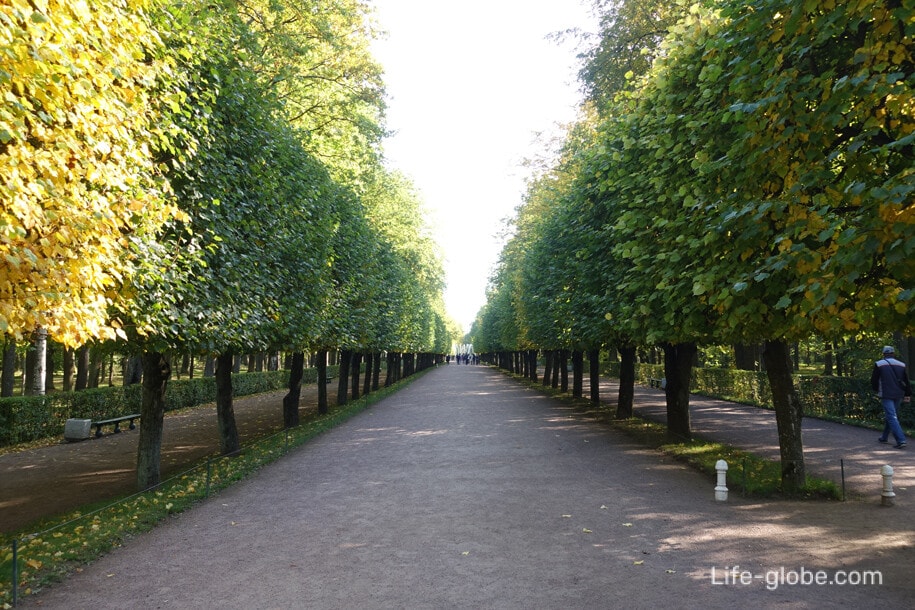
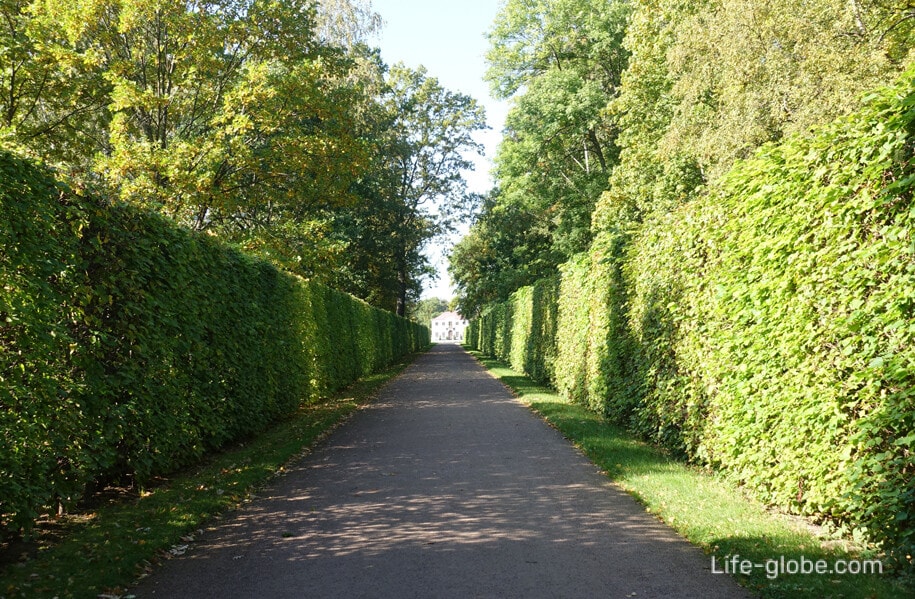
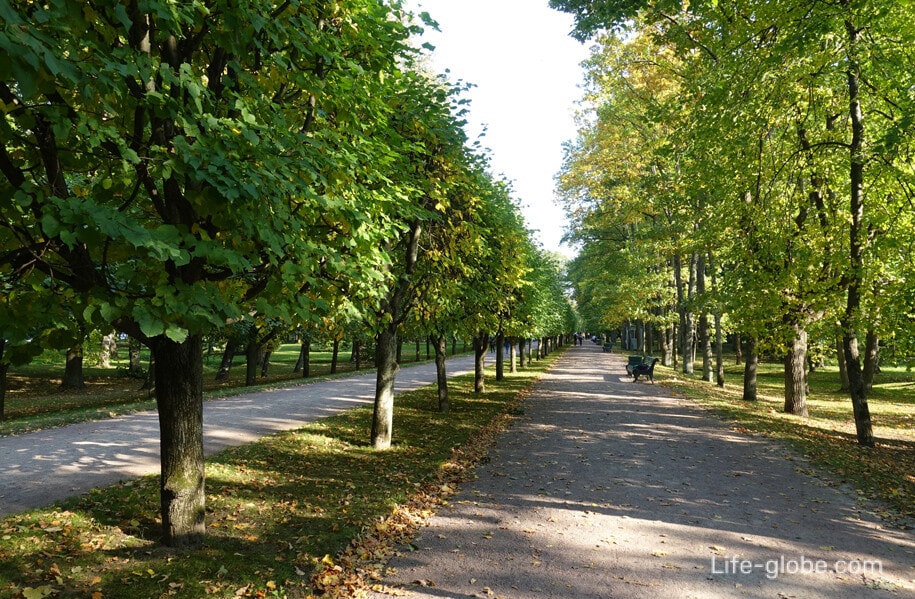
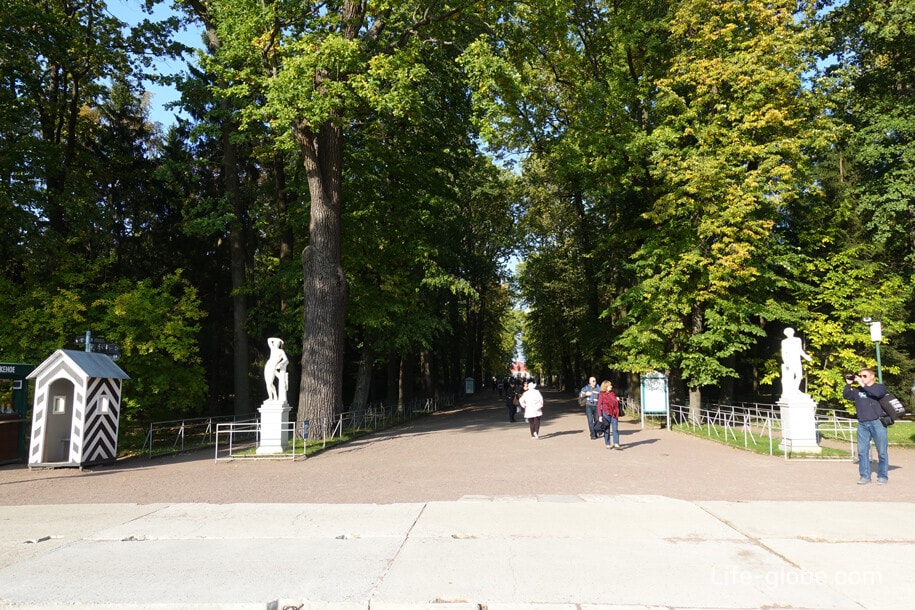
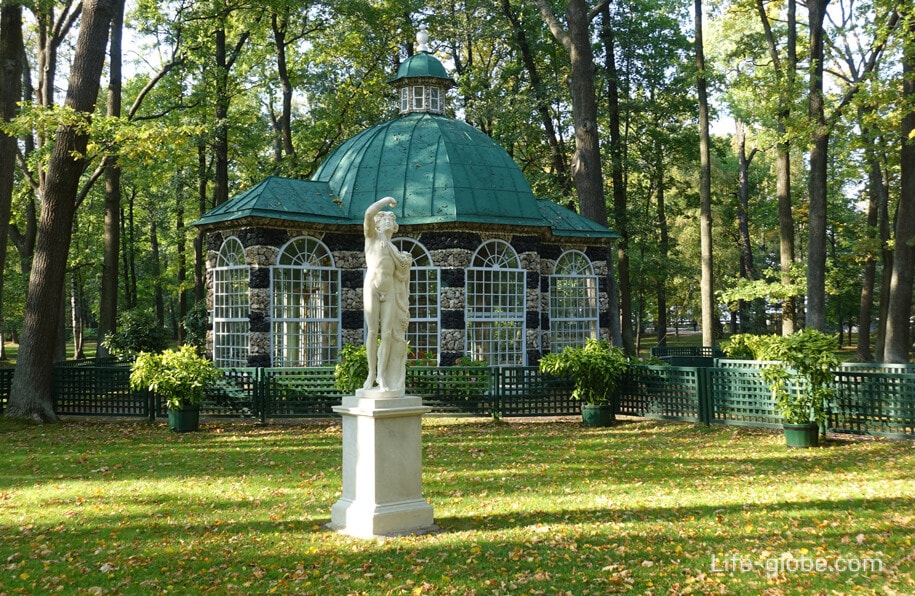
In the lower park, squirrels live, which willingly approach the guests of the park for treats.
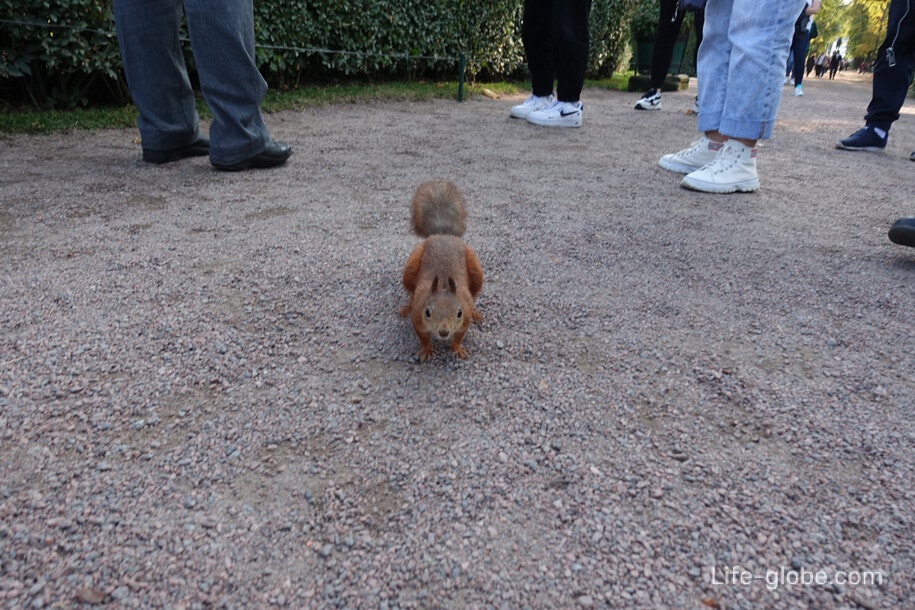

Video of squirrels in the Lower Park of Peterhof
Conventionally, the entire Lower Park is divided into three interconnected parts:
- central front part, located at the foot of the palace;
- the western part, which has the name "Marlinskaya" - after the Marli Palace located in this part;
- the eastern part, called "Montplaisir" - after the Monplaisir Palace located in this part.
In each part of the park there are small pavilions and palaces, as well as ensembles of fountains, flower beds and gardens.
The central part of the Lower Park, which is called the Front, is the most picturesque and is located at the foot of the Great Peterhof Palace.
This part of the garden consists of a slope near the palace and parterres with flower beds.

The central compositional place of the Front part of the park is occupied by the grandiose Grand Cascade Fountain with grottos and the Samson Fountain, which has become a symbol of Peterhof.
These fountains visually represent a single impressive and grandiose architectural and water ensemble of Peterhof. It is also one of the most outstanding buildings in the world.
The Grand Cascade Fountain consists of two massive seven-step staircases running down the slope in front of the palace, connected by arches of a Large Grotto and decorated with sculptures.
On the lower terrace of the Grand Cascade, in front of the entrance to the Large Grotto, there is a fountain "Basket".
The Grottos of the Grand Cascade are now a museum that you can visit for a fee.
The Samson Fountain, located in a bucket at the foot of the Grand Cascade, is a symbol of Peterhof. Learn more about the fountain ensemble with photos, videos, and descriptions…
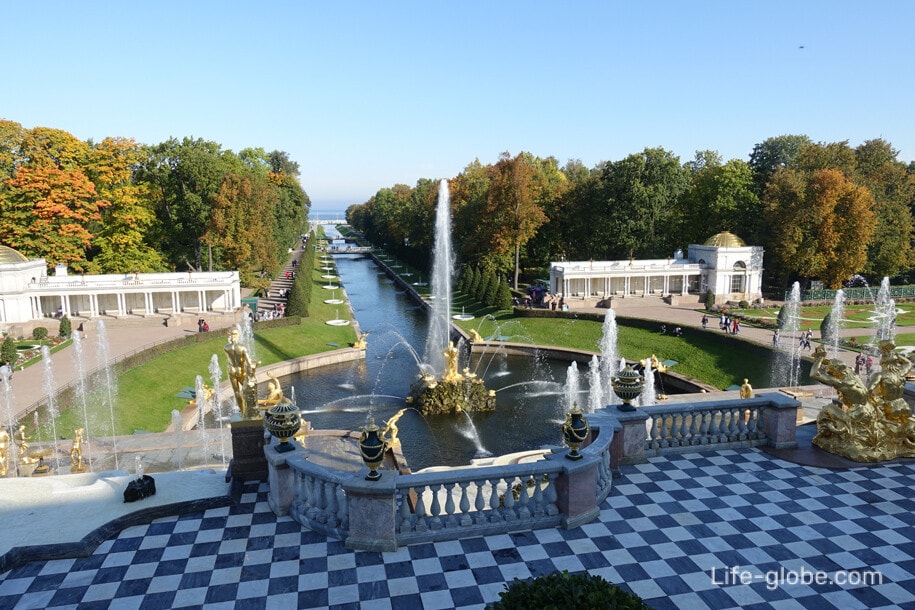
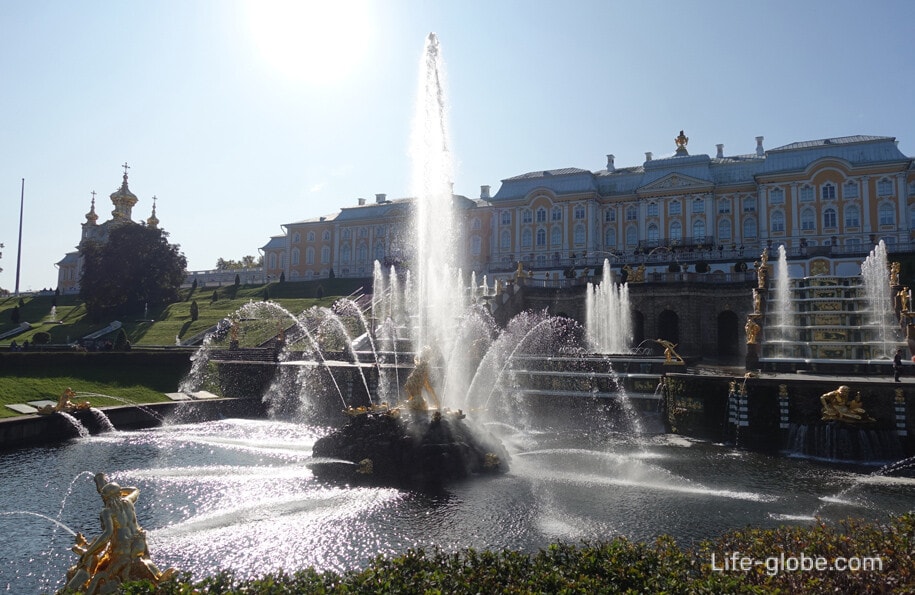
The slope of the Front part of the park adorns the complexTerrace fountains.
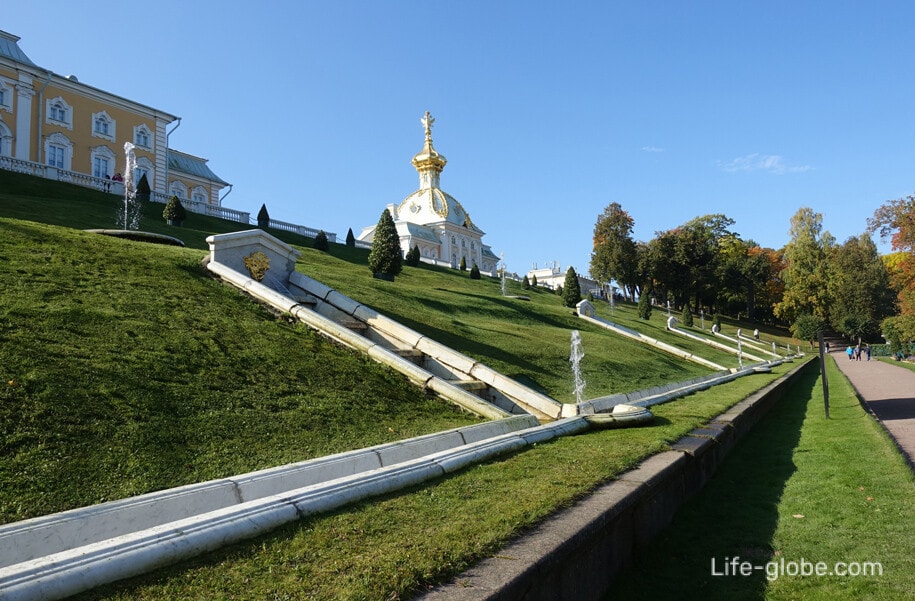
In the terraced part, on both sides of the Samson fountain, there are powerful and impressive Bowl fountains, near which, in the south-eastern and south-northern corners of the park's front area, there are fountains of marble benches "Nymph" and" Danaida".
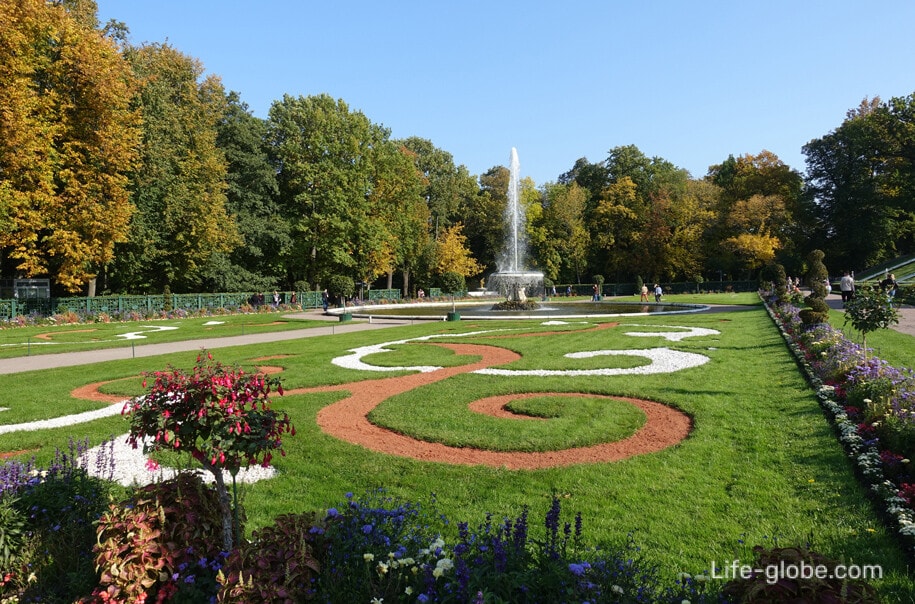
In the central northern part of the stalls, on both sides of the bucket with the Samson fountain, the water from which flows through the Samson Canal to the Gulf of Finland, there are powerfulVoronikhinsky colonnades.
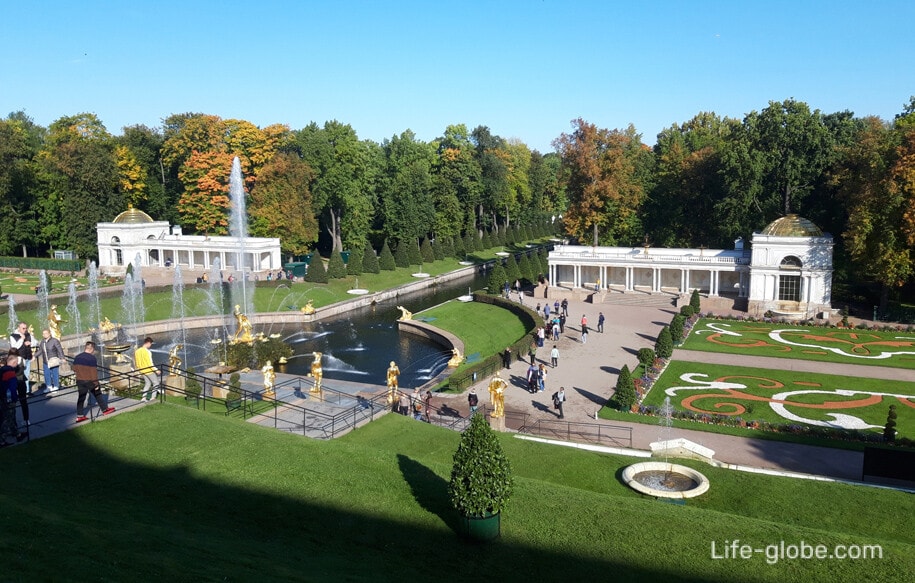
The sea (Samsonovsky) channel originates from the bucket with the Samson fountain and leads to the pier in the Gulf of Finland.
Initially, the canal served as the main entrance to the territory of the palace complex. Guests arrived in Peterhof by ship, after which they were transferred to boats and light vessels that passed through the channel to the bucket, which then served as a harbor (the Samson fountain under Peter I was not yet there).
Today, the "Meteor" excursion ships are moored to the pier in the Gulf of Finland, delivering guests of the park from/to the center of St. Petersburg.
Along part of the canal runs an Alley of Fountains, which has 22 fountains ("Niche" fountains), and the canal itself is crossed by pedestrian bridges. Learn more about the Front part of the Lower Park with parterres, fountains and Voronikhinsky colonnades (+photos and videos)…
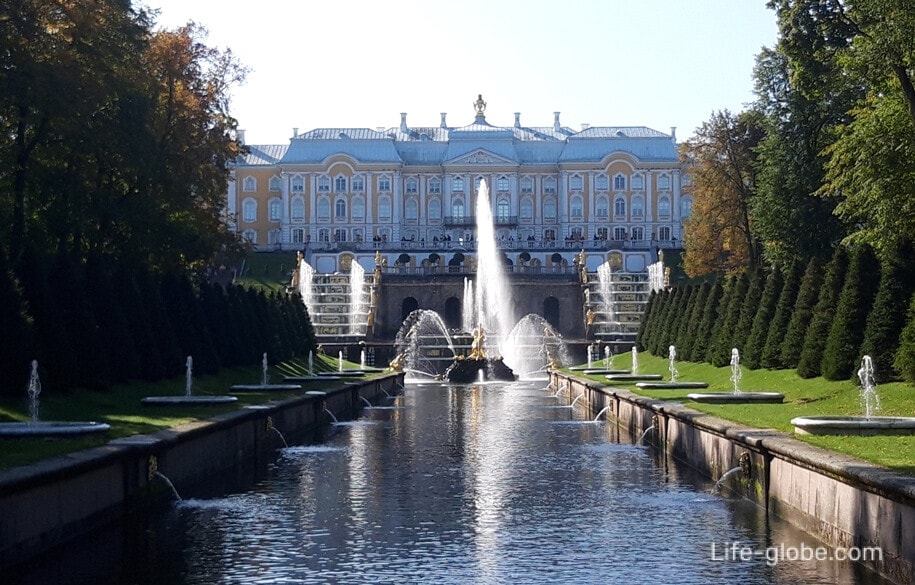



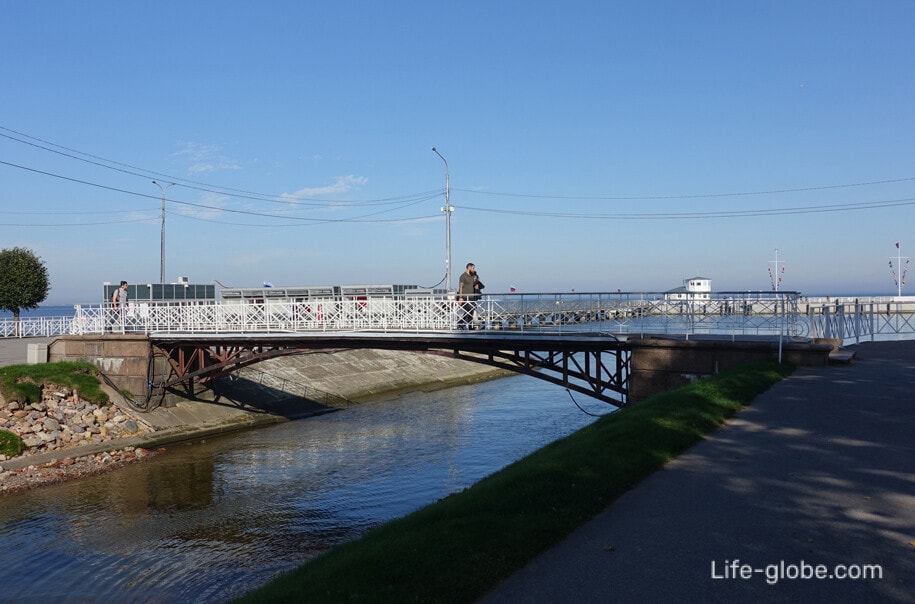
Marina view
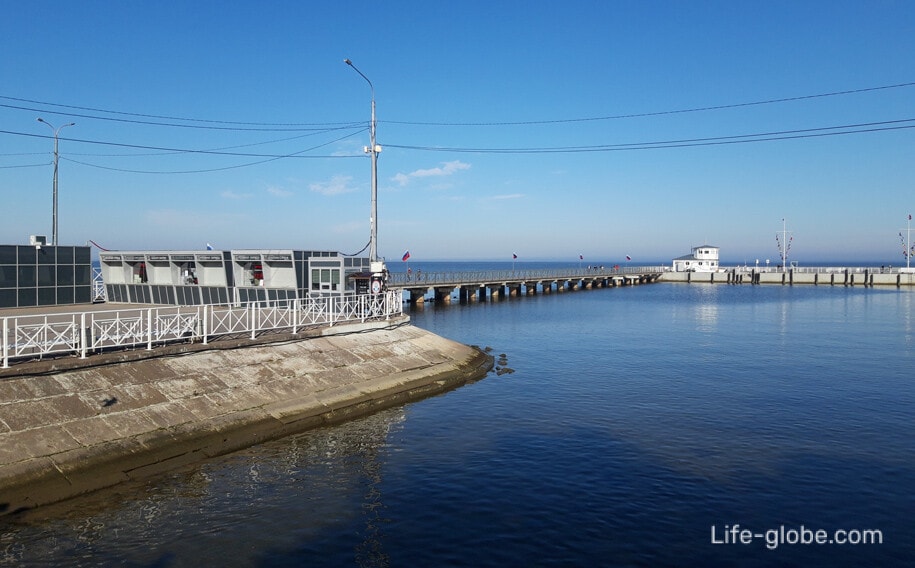
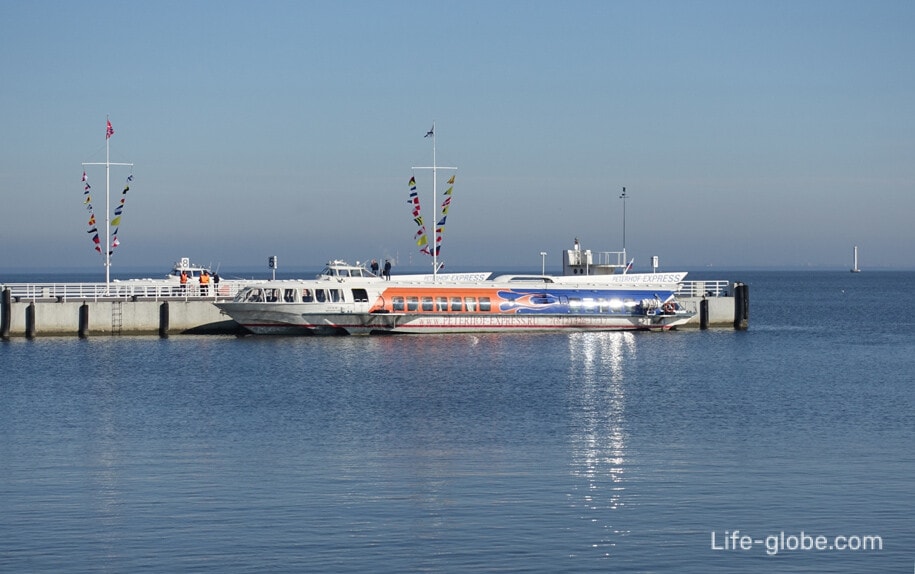
The Lower park is quite large, and those guests of the park who can not or do not want to walk through it on foot can take a walk around the park on open tour cars with an audioguide .
Excursions are paid. The cost is from 700 rubles, children up to 7 years old without taking a separate place-free of charge.
Tickets can be purchased and you can start a tour of the park in the eastern part of the Front part of the park - at the Sand Pond.
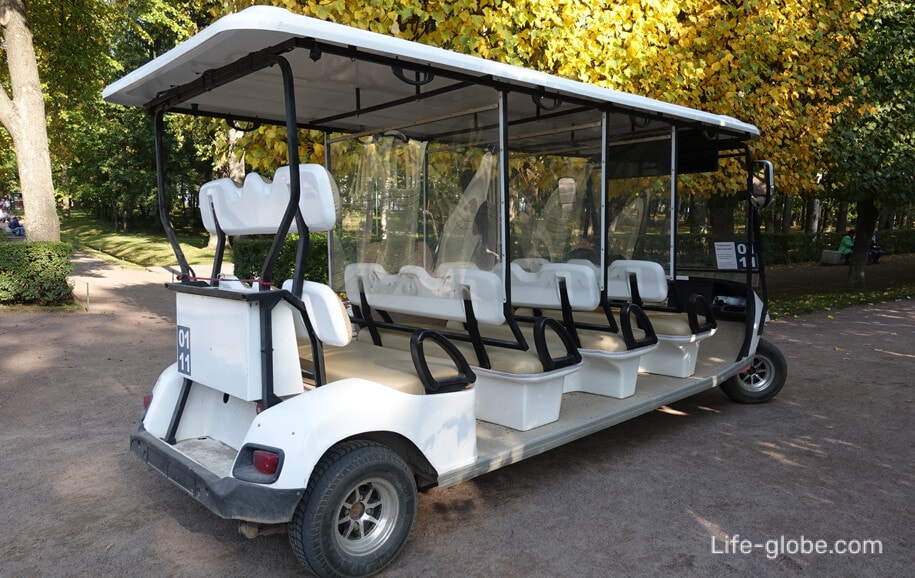
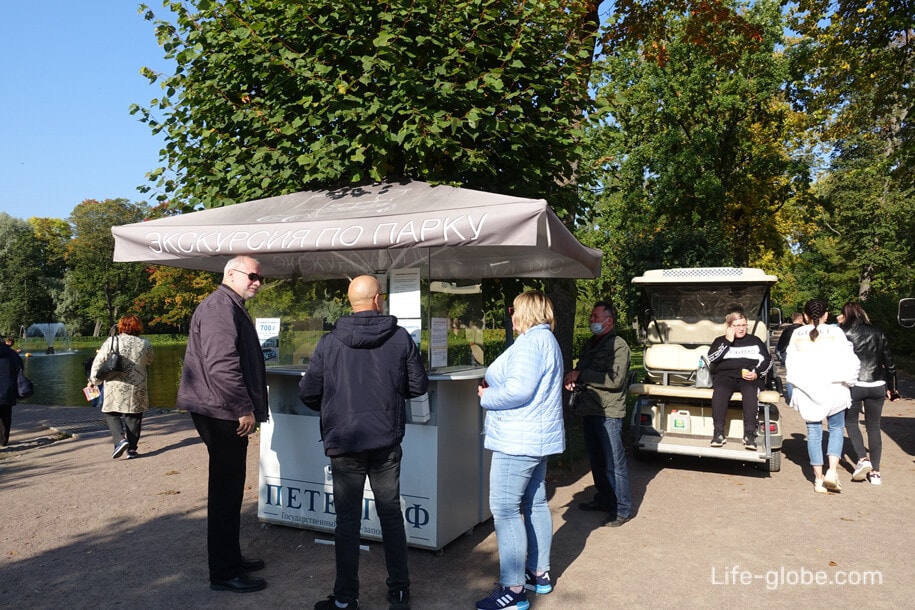
Adam and Eve Fountains
On Marlin Alley, which crosses the Sea Channel of the park, in the eastern (fountain Eve) and western (fountain Adam) sides of the park, equidistant from the channel, there are fountains Adam and Eve.
These two fountains are paired and differ only in the marble central figures, which are installed on high pedestals in the centers of the fountain pools. Near the plinths there are sixteen small tubes, from which water jets beat to a height of seven meters, and the water is not sprayed, but splits into separate large drops that are clearly visible from afar.
In the 18th century, the fountains were surrounded by trellis gazebos, which served as shelters from the weather and for recreation on hot sunny days. Today, elegant modern structures remind us of gazebos. Learn more about the Adam and Eve fountains…
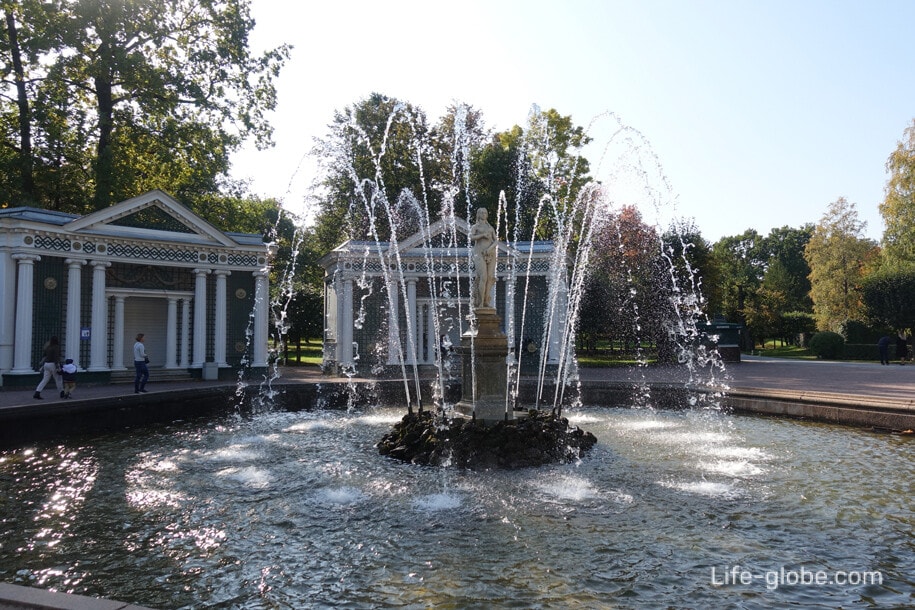
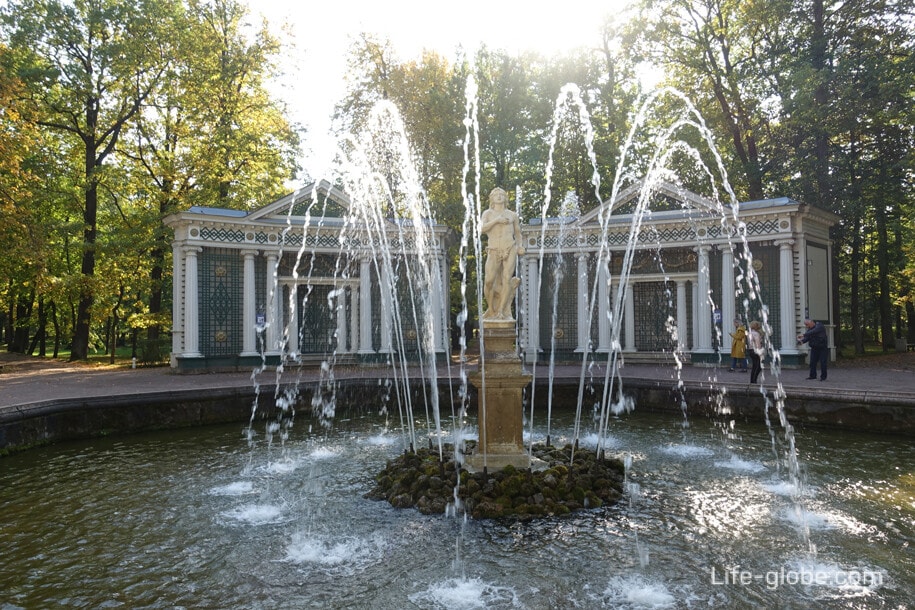
The western part of the park was named Marlinskaya, - from the main small palace of Marli, located in this part of the park.
The Marly Palace is one of the pavilions, the so-called small palaces, which was built by order of Peter I in 1720-1723 by the German architect-decorator Johann Friedrich Braunstein.
The palace was used as a guest house for the residence of nobles and members of the imperial family.
Today, the palace houses a museum, whose collection tells about the time of Peter the Great and contains memorial items related to the personality of the first Russian emperor; the basis of the museum's painting collection consists of paintings, including works by Adam Silo, Abraham Stork, Pietro Belotti and other artists.
Entrance to the Marly Palace Museum is paid. More about the Marly Palace…
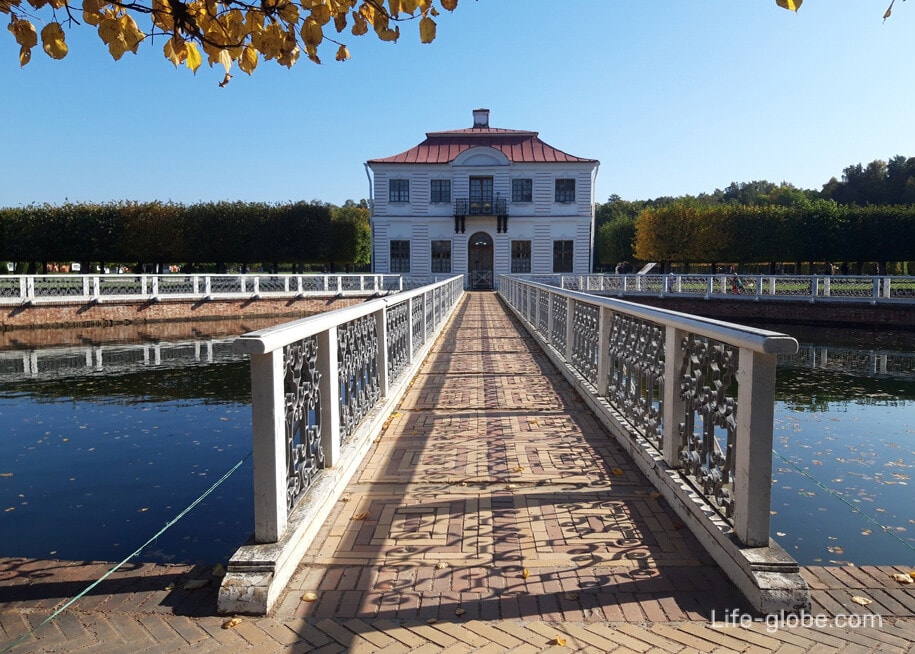
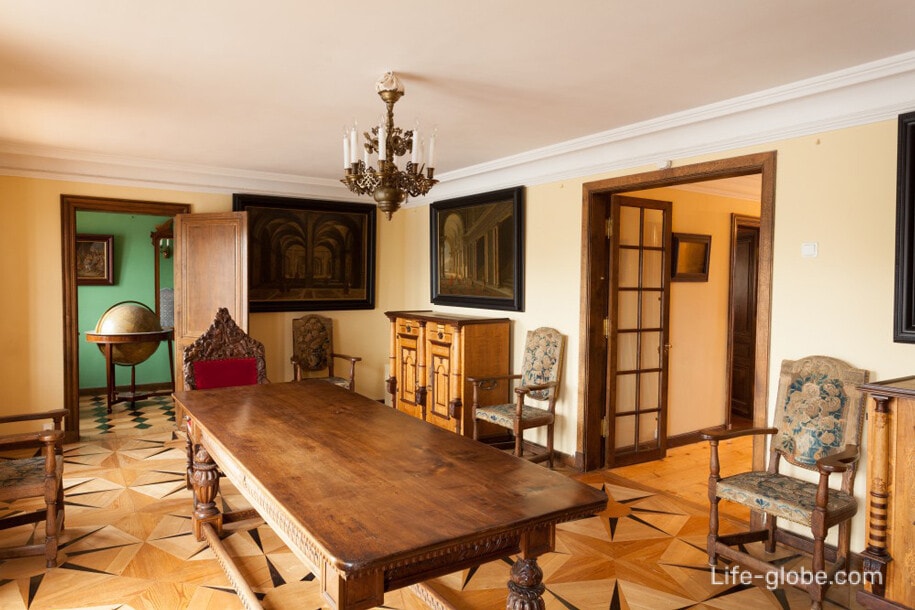
The Marly Palace cannot be perceived separately, it is the center of the so-calledThe Marlin Ensemble.
The Marli Palace stands on an artificial bridge between the Sectorial and Large Marlin Ponds, which were created at the same time as the palace and in which fish were bred for the royal table. This tradition is still alive today - fish still live in the ponds and at certain hours the fish is fed, calling it by ringing a bell.
The most impressive is the Large Marlin Pond, located in front of the palace (on its eastern side).
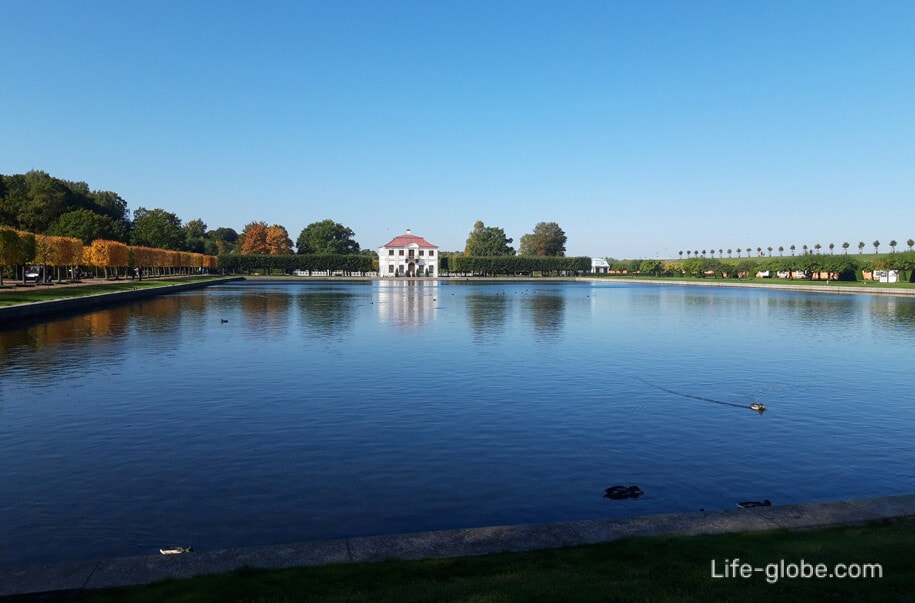
The sector pond, or "small pond", is located behind the palace (on its western side). This pond is small, made in the form of a semicircle and is divided into four sectors - hence the name of the pond.
Even under Peter I, the banks and three dividing dams of the pond were decorated with Dutch brick-clinker.
On the dams there are pedestrian bridges with iron openwork grilles and railings.
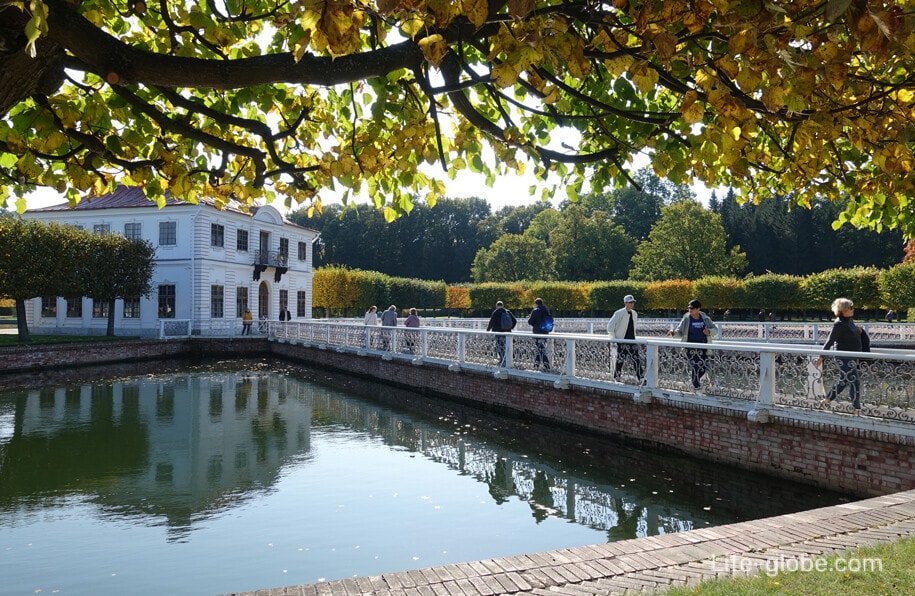
On the north side of the Large Pond, directly near the Gulf of Finland, is the Garden of Venus, which was used to grow fruit for the imperial meals.
The main decoration of the garden, from which the garden received the name "Venus", is a marble statue of Venus of Media, made on the model of the famous ancient Greek sculpture.
Behind the statue of Venus, along the entire garden, there is a retaining wall with balustrades and a wide staircase.
The garden terraces offer views of the Marli Palace itself with its surrounding ensemble and the Gulf of Finland. Learn more about the Garden of Venus…
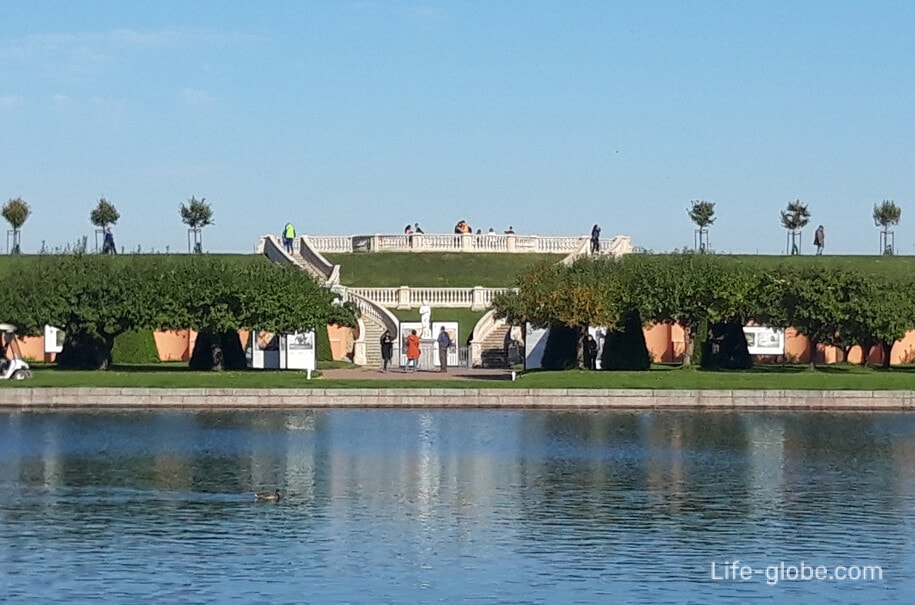
On the opposite side of the Large Pond from the garden of Venus (south) there is a terrace decorated with fountains and sculptures: the Golden Mountain cascade, two Menagerie fountains, four Tritons-Bellsfountains, genre sculptures Air and Earth.

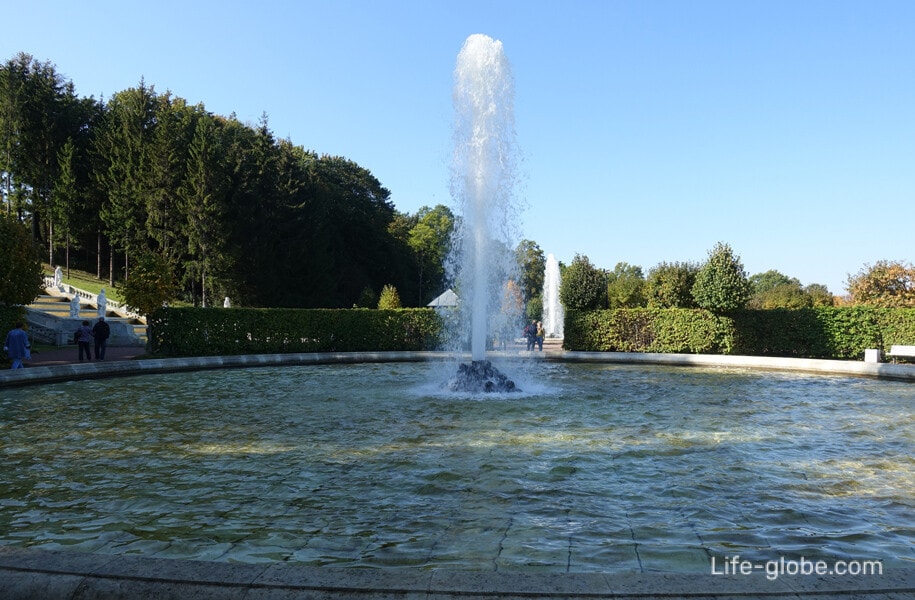
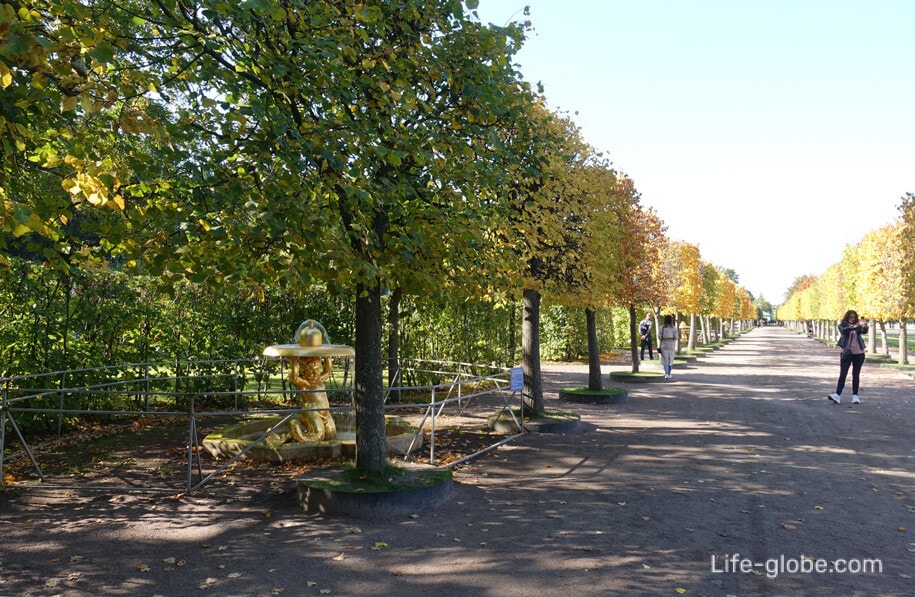
On the west side of the Marly Palace are located: the genre sculpture "Athena Giustiniana" and the Bacchus garden, which originally had a utilitarian meaning - in the garden, Peter I tried to grow grapes, but due to the climate of St. Petersburg, the idea could not be realized.
Today, the Bacchus Garden is a walking area with lawns that are framed by ornamental trees and flowers, including roses.
The center of the garden is decorated with a monumental monument to Peter I, which is a sculptural group mounted on a high three-stage pedestal, which depicts Peter the Great with Louis XV in his arms. Learn more about Bacchus Garden…
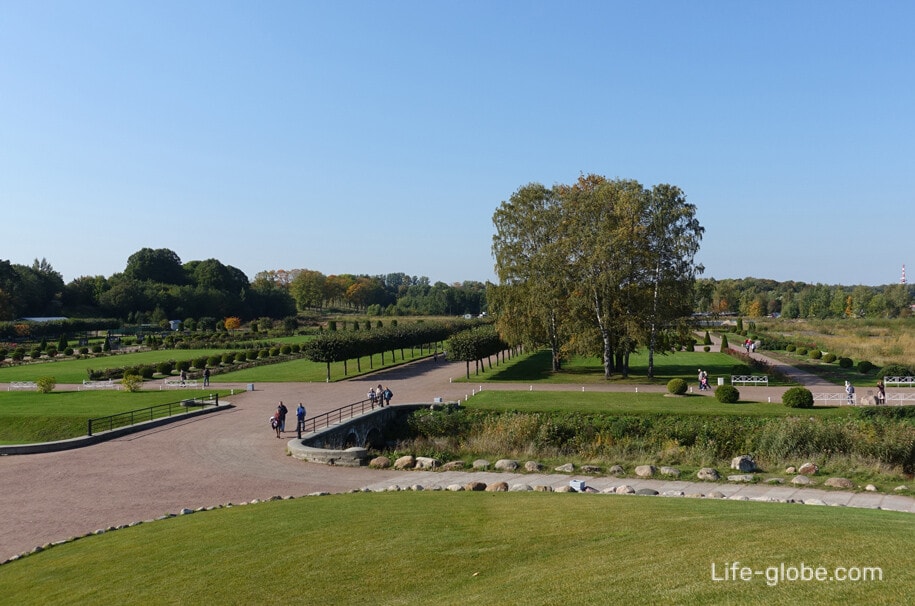

Almost at the waters of the Gulf of Finland is the Hermitage pavilion, the construction of which began in 1721 according to the project of the architect I. Braunstein.
The Hermitage is a small two-story building, standing on a massive base-a stylobate and surrounded by a deep, wide moat. The moat was previously filled with water and a drawbridge was thrown over it.
Today, within the walls of the Hermitage pavilion, there is a museum, the jewel of which is a table with a lifting mechanism-a miracle of technology of the first quarter of the 18th century. Entrance to the museum is paid. Learn more about the Hermitage Pavilion»…

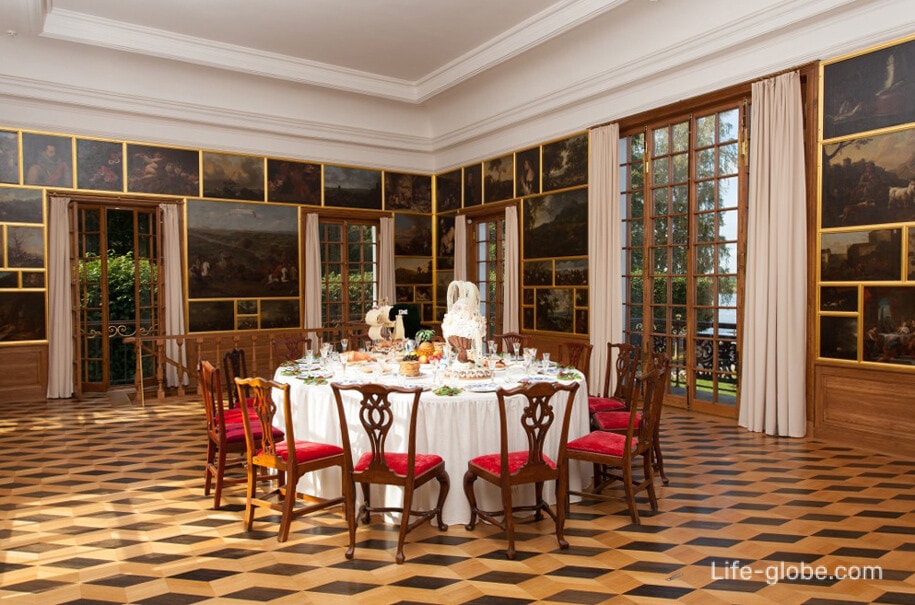
In 1801, according to the project of the architect and painter Andrey Nikiforovich Voronikhin, the Hermitage Cascade fountain, which is now known as the fountain, was built near the Hermitage pavilionLion cascade.
The fountain has a late classicist style. It consists of a monumental colonnade set on a high granite plinth. From the 12 bowls located between the columns of the colonnade, water jets beat. In the lower part of the fountain, on the plinth, there are mascarons, from which water streams flow into the fountain pool. On the sides of the colonnade of the fountain, on pedestals, there are bronze figures of "guard" lions, from the mouth of each of which streams of water flow.
In the center of the fountain is decorated, located on a granite "rock", a statue of the nymph Aganippe-the patroness of the eponymous spring at the foot of Mount Helikon. According to legend, people drinking from this spring were poetically inspired. The statue was created on the model of F. P. Tolstoy. Learn more about the Lion Cascade with photos and videos…
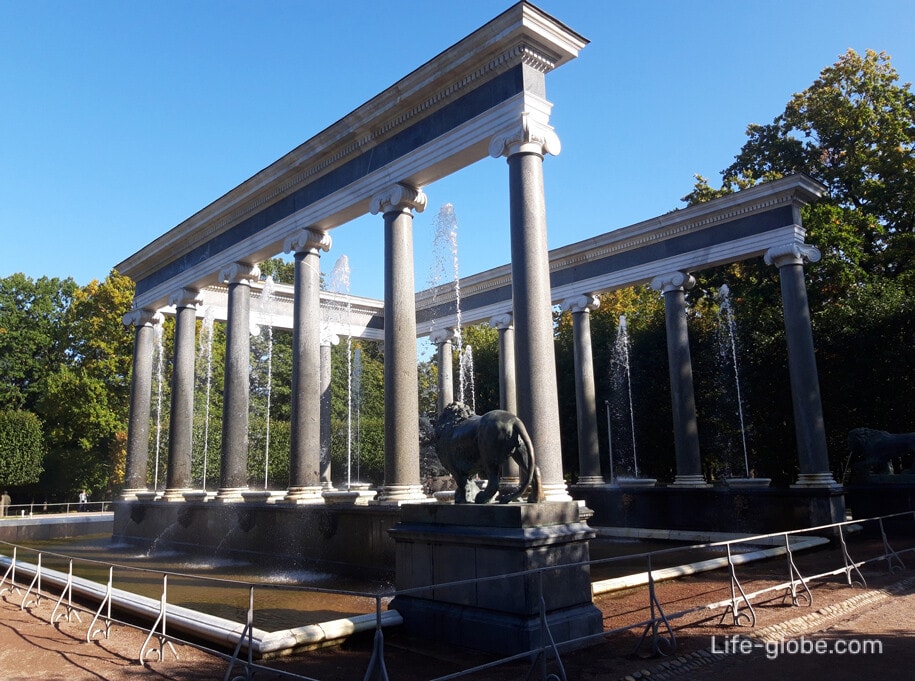
In the north-eastern zone of the western part of the park, in a natural green environment, there are ponds: Evinsky and Pesochny.
The man-made Sand Pond is decorated with a small but fascinating Whale fountain. Learn more about the fountain and pond…
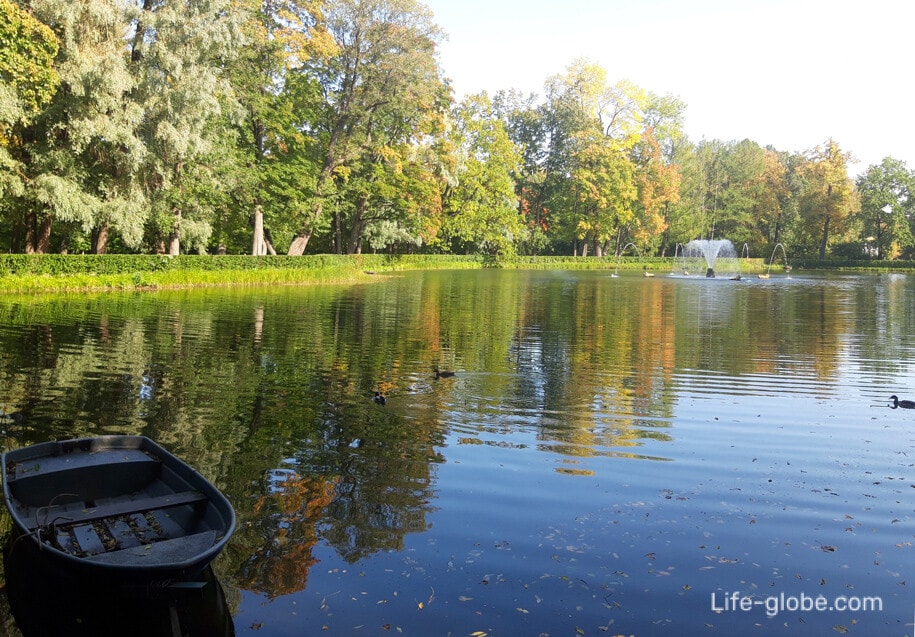
Not far from the pond, behind the western Voronikhinskaya colonnade, you can see a small fountain "Favoritka" with moving figures of ducks and a dog. Learn more about the Favorite fountain with photos and videos…
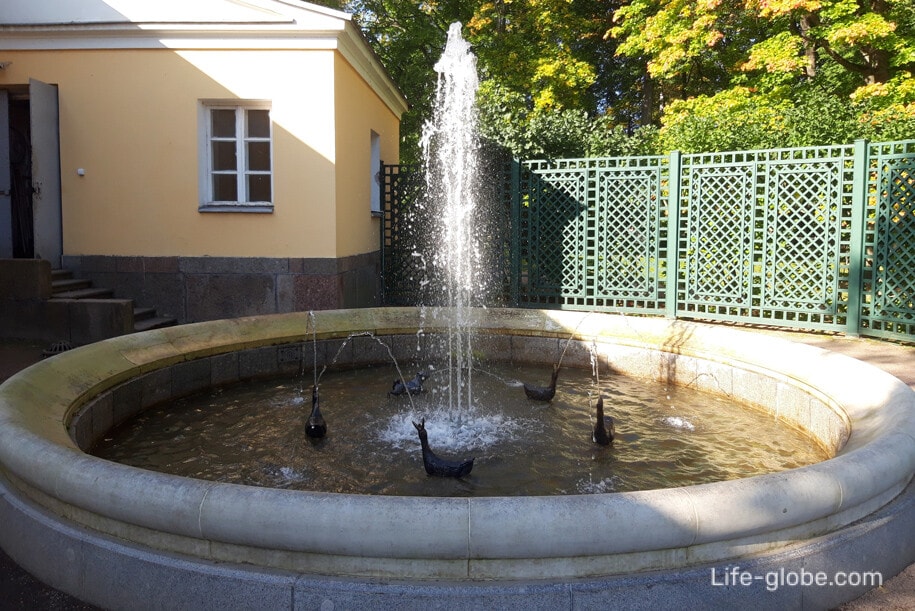
Near the Gulf of Finland, there is a natural vegetation area with places for walking and a lighthouse.
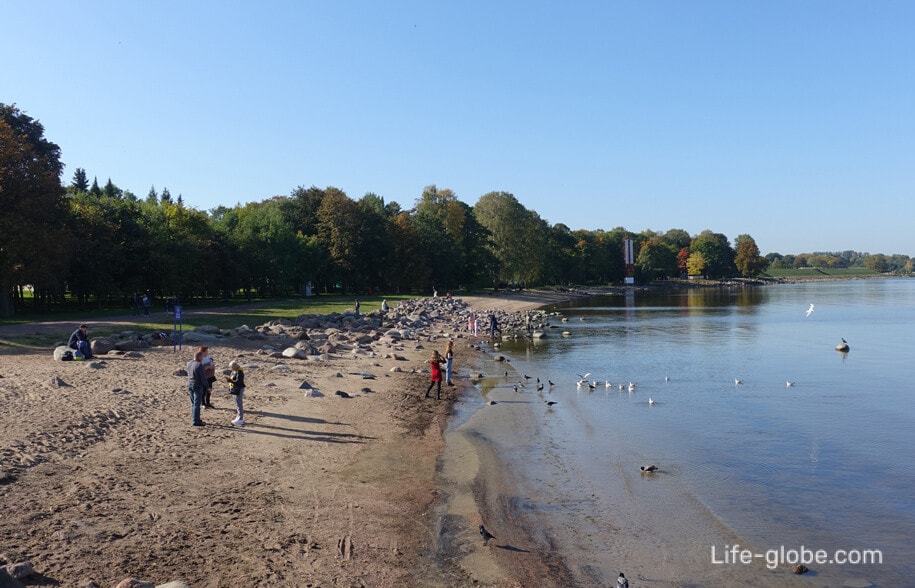
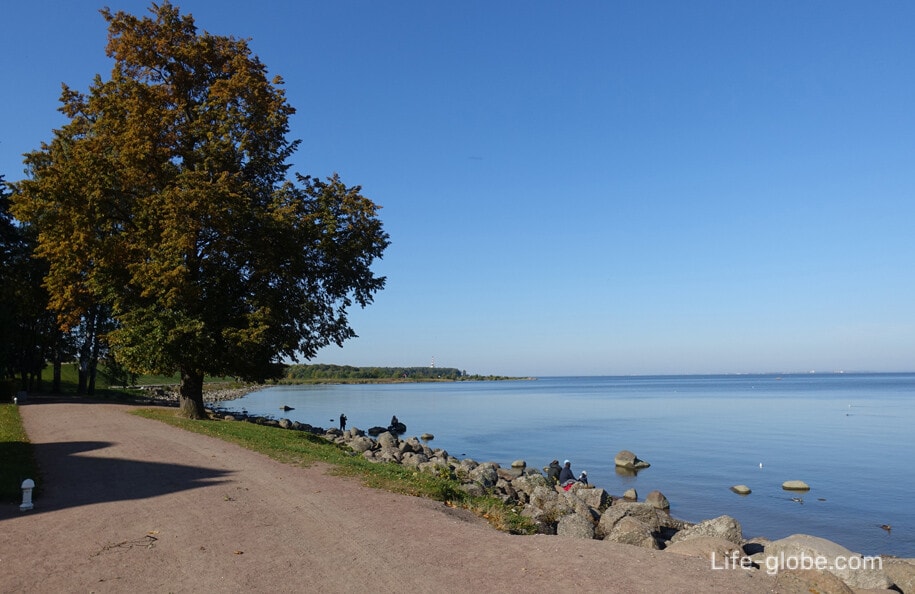
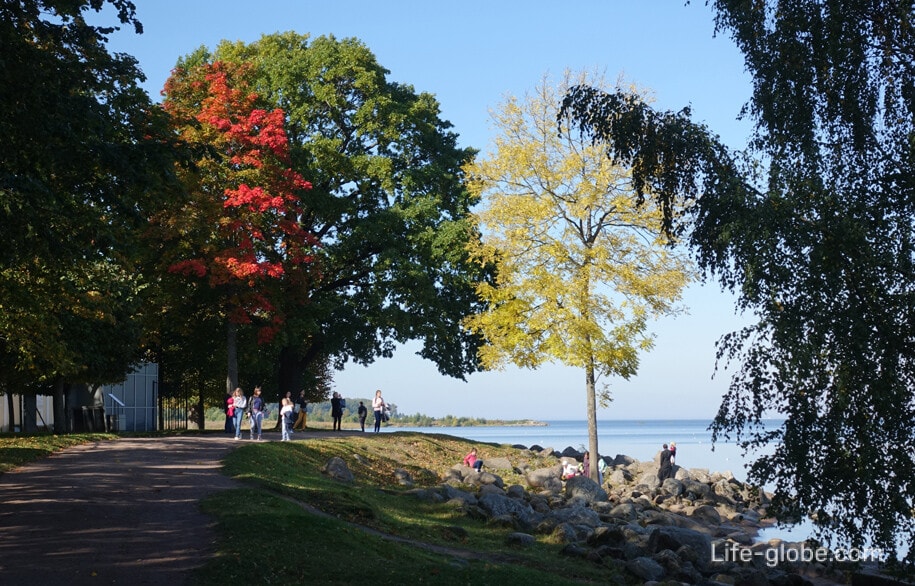
In the eastern part of the Lower Park, compared to the other two, there is a more extensive natural vegetation area for walking.
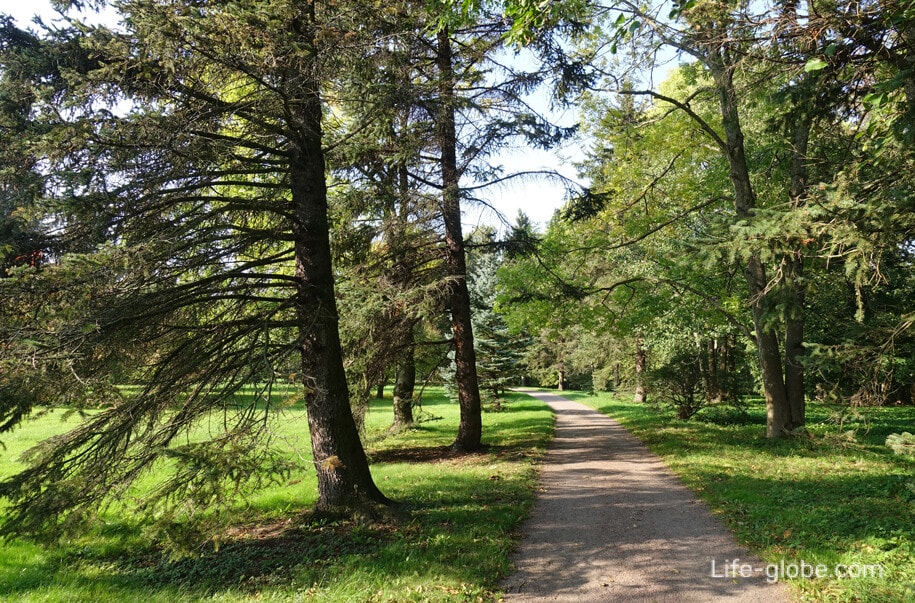
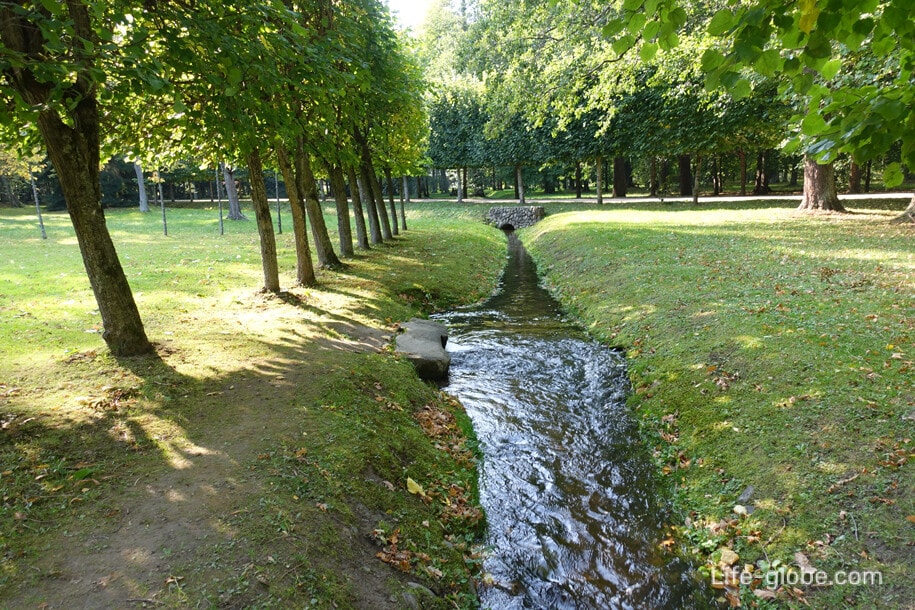
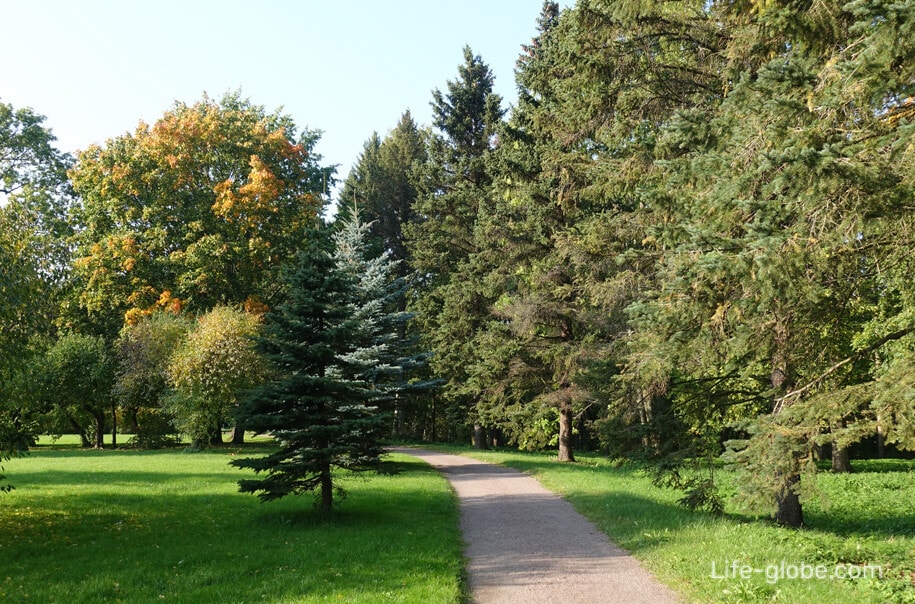
There is a lighthouse near the Gulf of Finland.
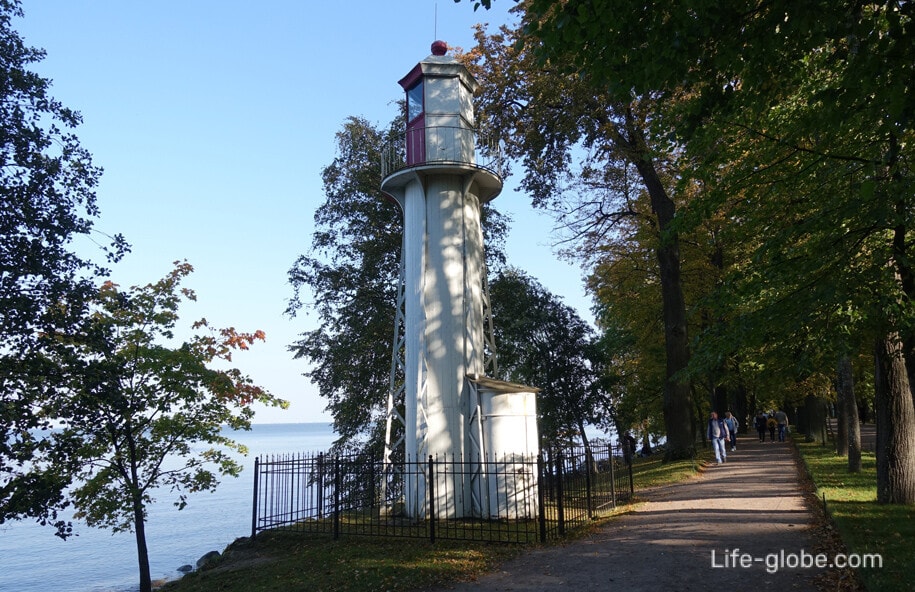
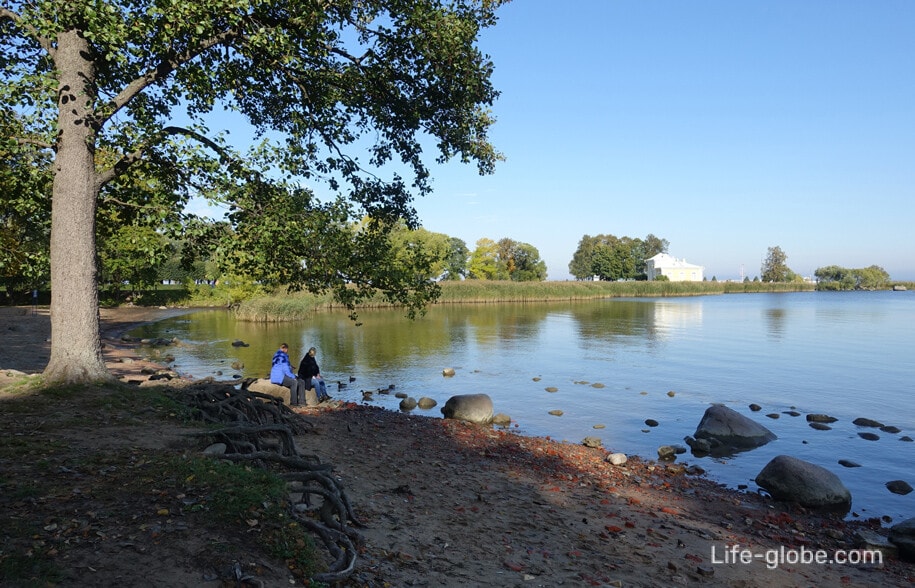
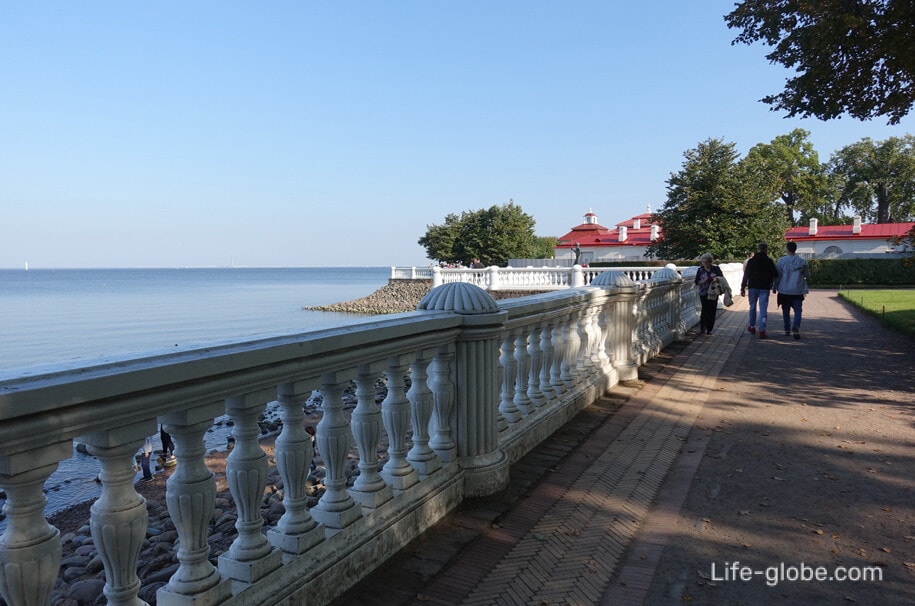
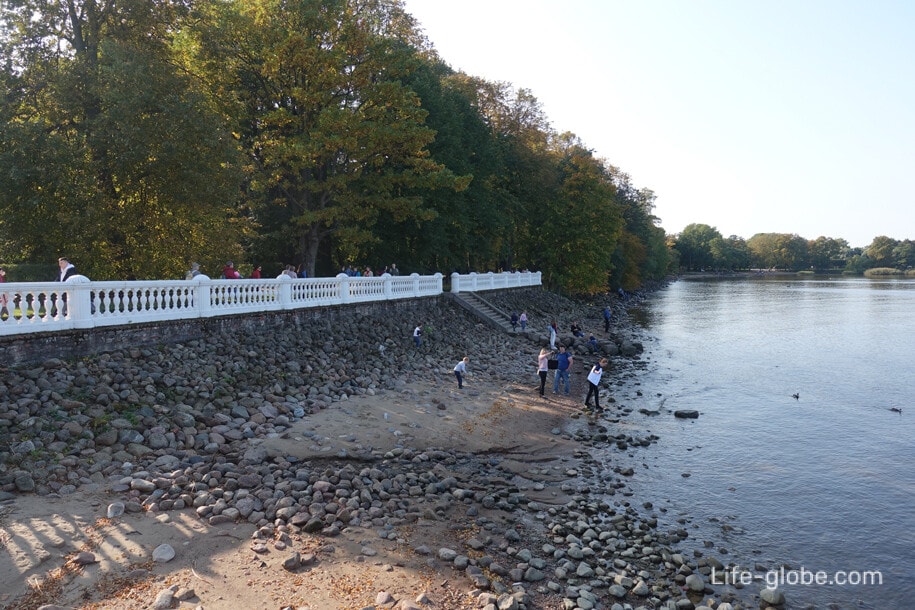
Near the harbor of the Gulf of Finland, in a small building, you can visit the museum "Imperial Yachts", which is also called the Maritime Museum.
The museum's exposition is dedicated to an unfamiliar page in the life of the imperial family - the history of the St. Petersburg fleet and the construction of yachts, which was initiated by Peter I, gained strength during the reign of Catherine II, and a special flourishing began during the reign of Nicholas I.
Entrance to the museum is paid. Learn more about the Imperial Yachts Museum»…
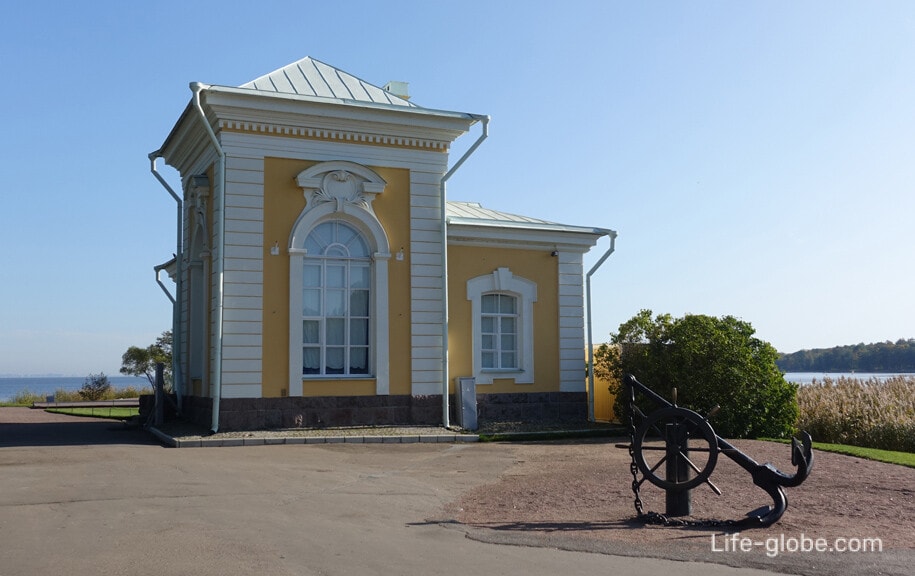
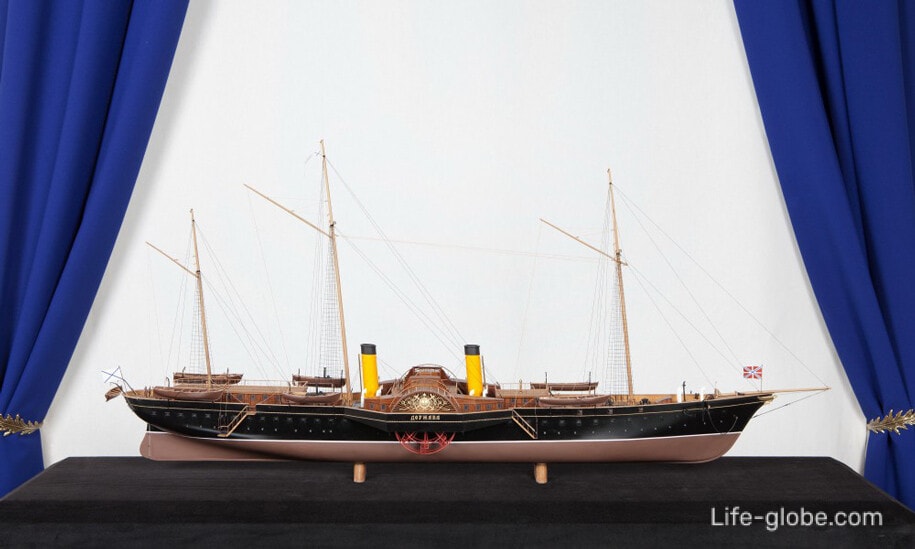
The main complex of the western part of the Lower Park isThe Montplaisir Ensemble, which includes:
- the palace of Montplaisir, from which the ensemble itself and the entire eastern part of the park were named.
The palace was built in 1714-1723 according to the plan of Peter the Great.
Today, within the walls of the palace there is a museum with corridors, rooms, an office and a kitchen. Entrance is paid;
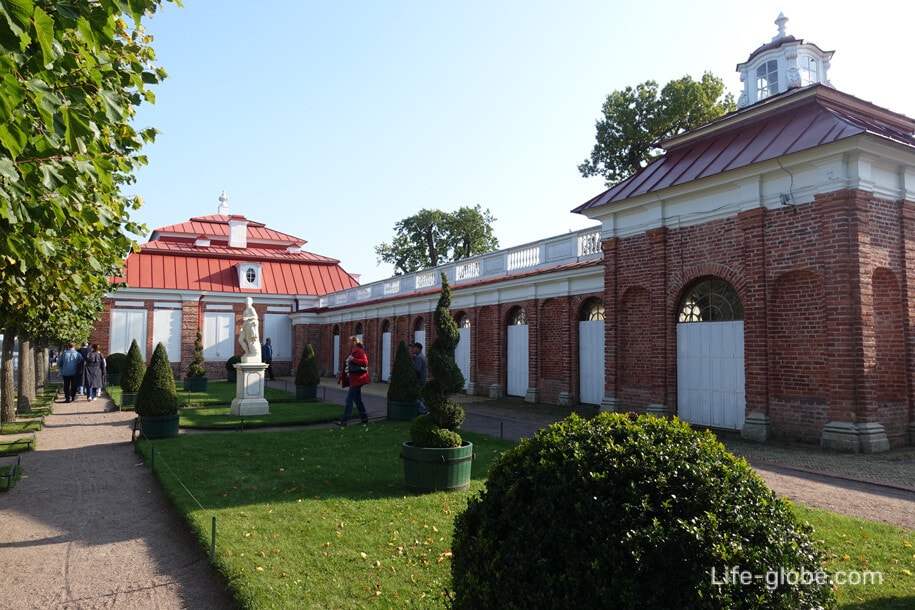
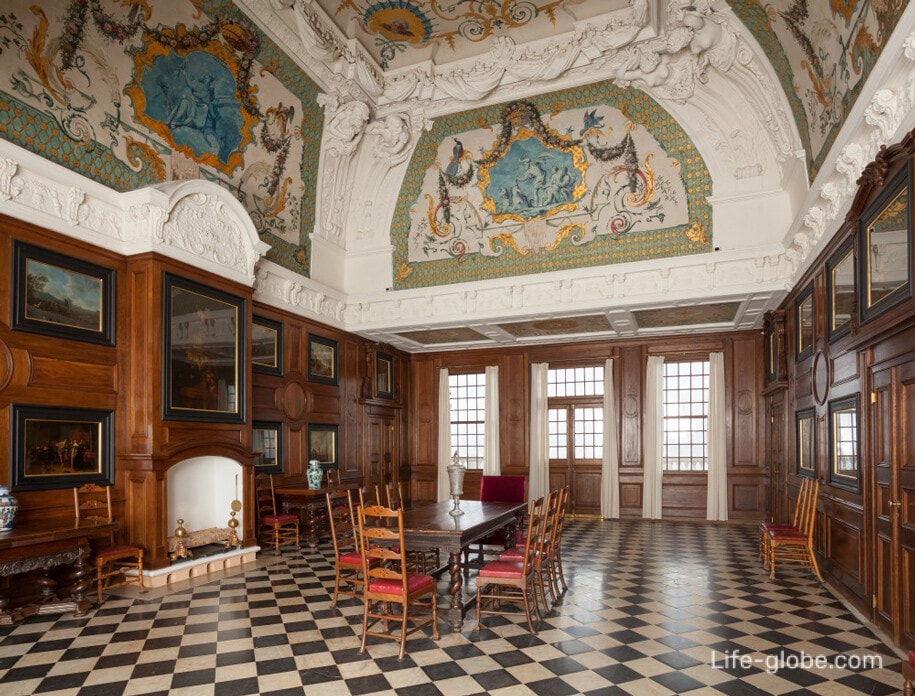
- Catherine's Building, built in 1747-1759 by the architect Francesco Rastrelli by decree of the Empress Elizabeth Petrovna (daughter of Peter I).
The palace was intended for holding court balls, receptions and banquets.
Initially, the palace was called the "Stone Building". It was renamed Catherine's Palace, after Catherine fled from its walls, who, as a result of the coup, ascended to the throne as Catherine II.
Today, in the camps of the Catherine Building there is a museum with the cabinet of Alexander I and the halls. Entrance to the museum is paid;

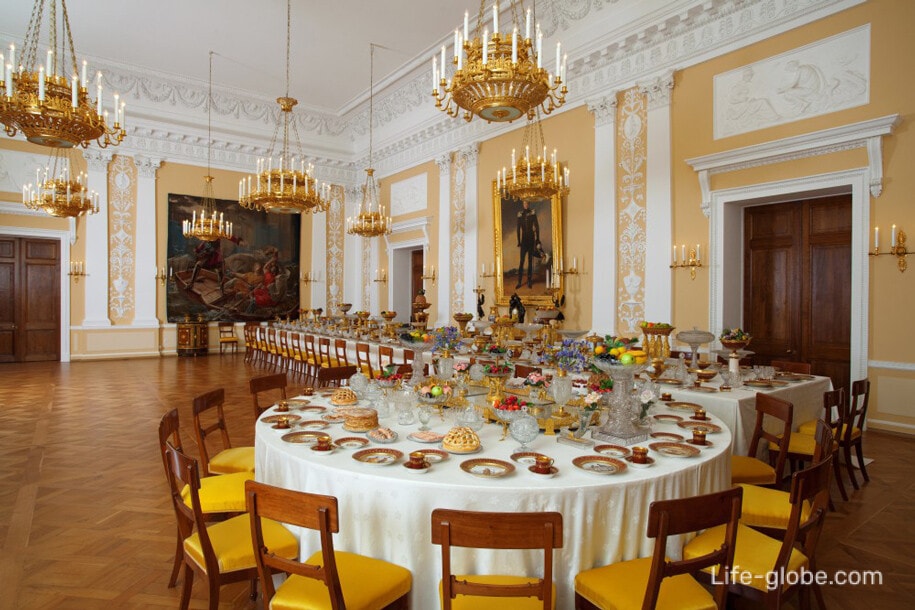
- Bath building, which is a complex of buildings for ceremonial and household purposes, built at different times.
Today it is a museum. Entrance is paid;
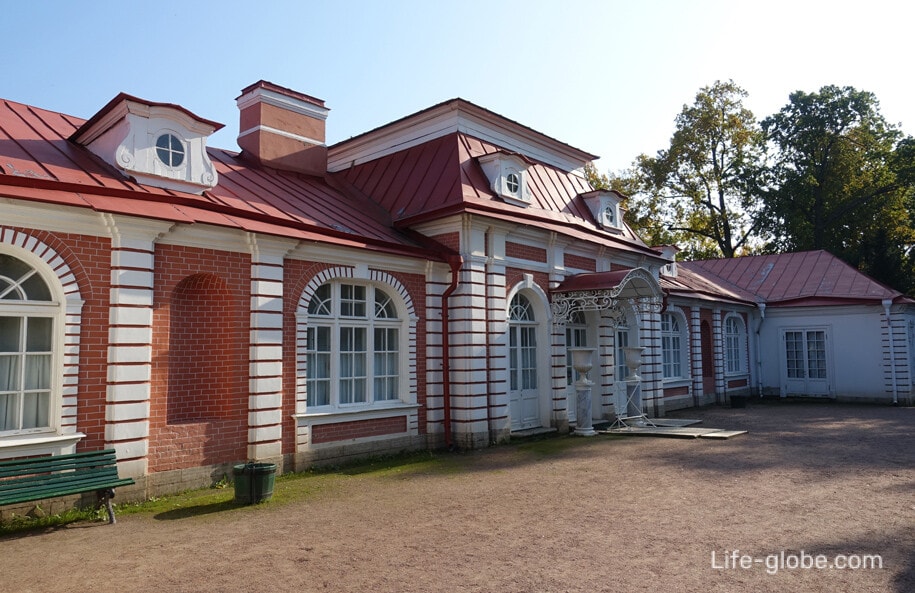
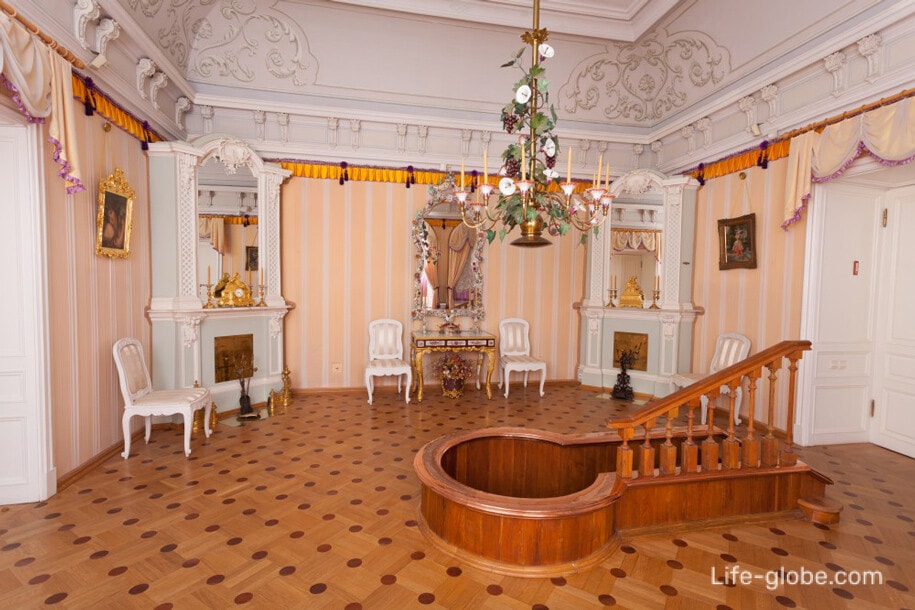
- Montplaisir Garden, located in the center of the above buildings and which contains flower beds, ornamental shrubs, trees, four fountains "Bells", a powerful and lush fountain "Sheaf". Read more about the Montlaisir Ensemble with photos and videos…

On the side of the Gulf of Finland, an alley runs along the Monplaisir Palace, where there are: an observation deck with views of the Gulf of Finland and three genre sculptures-Neptune, Amphitrite and Summer.
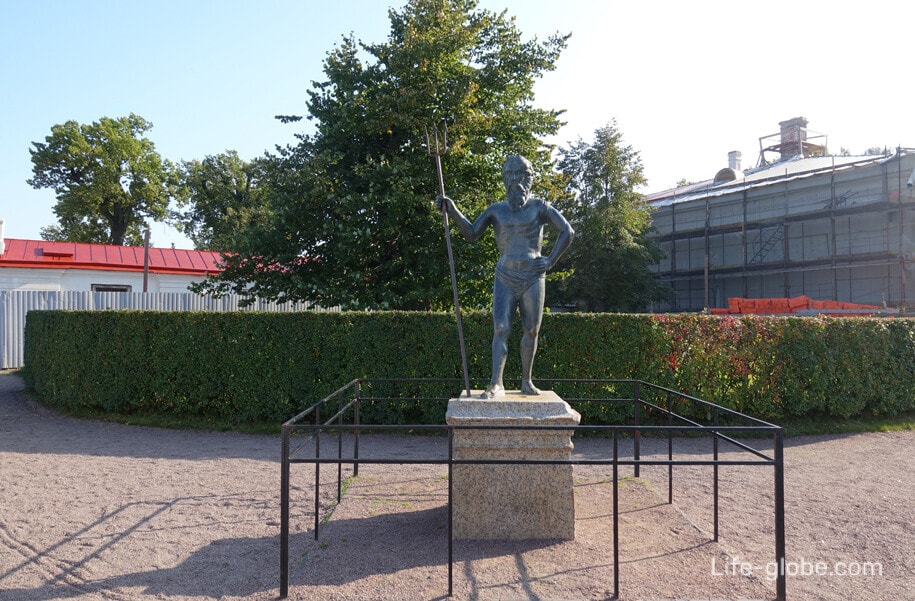


At the place where the Marlin and Montplaisir alleys intersect, a monument to Peter I is erected on a high pedestal.
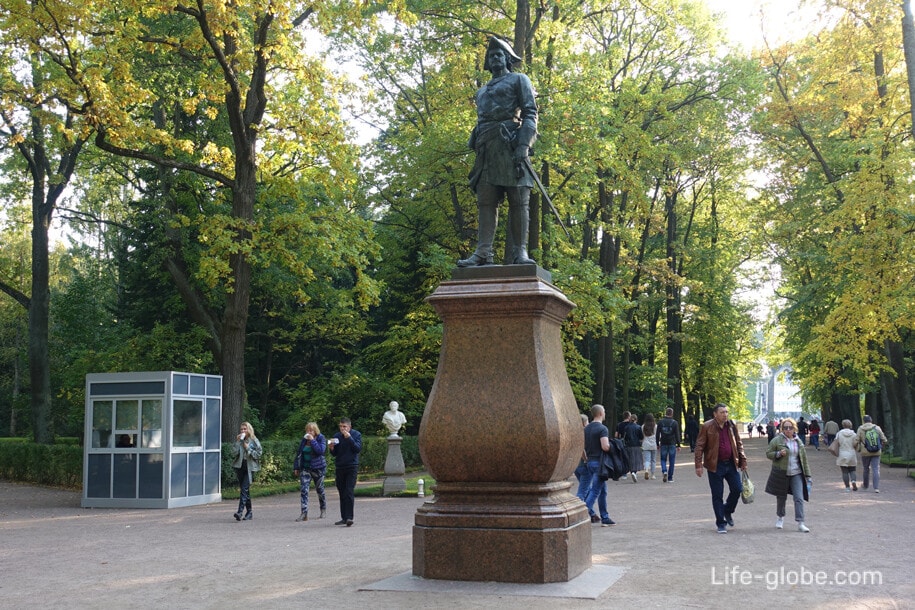
The end of the Montplaisir Alley is marked by flower stalls, between which are placedRoman fountains - an ensemble of two fountains with the same design and decoration.
The name of the fountains "Roman" is due to the fact that the fountains in the composition resemble stone water cannons in Rome on the square in front of St. Peter's Cathedral.
The fountains appeared in 1739, designed by architects I. Ya. Blank and I. P. Davydov.
Today, the fountains are among the most impressive, large and beautiful in the park. Each of the fountains has a lower pool and two tiers, as well as five water cannons. The height of the fountains is more than 10 meters. Learn more about Roman fountains with photos and videos…

Near the Roman fountains there is a cascade of Chess Mountain, which has steps painted with black and white squares in a checkerboard pattern, as well as sculptures of winged dragons and grottos. Learn more about the Chess Mountain cascade with photos and videos…
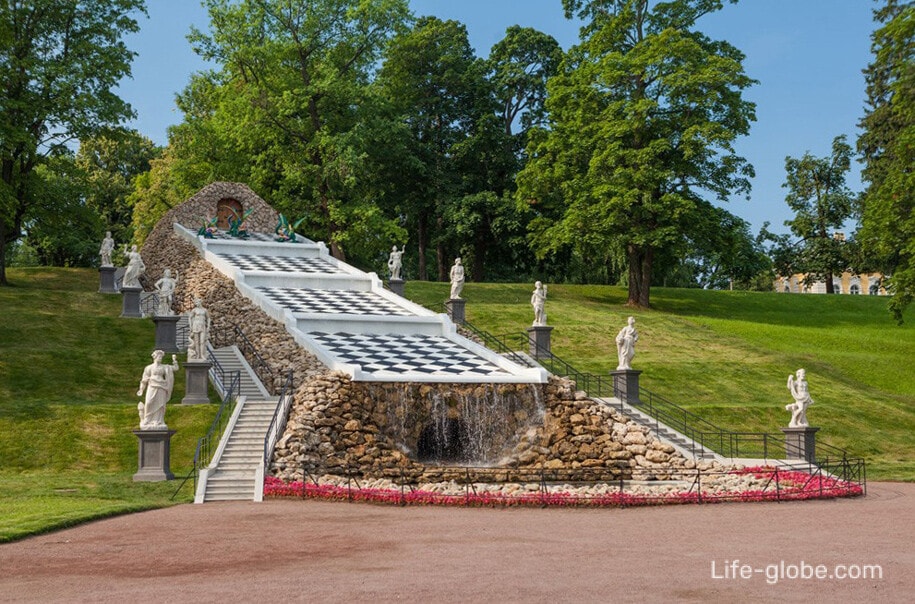
The fountain "Sun", which adorns the Menagerie Pond, was originally part of the menagerie garden created by Peter I.
Under the Empress Catherine II, designed by architects AND. Yakovlev and Yu. Felten arranged a royal bath in the pond. The fountain was redesigned and named "The Sun" after the pattern of the jets of the central part of the fountain: on a round pedestal decorated with sixteen gilded dolphins, a bronze column was installed, completed with gilded disks, and a mechanism with a water wheel was hidden in the pedestal.
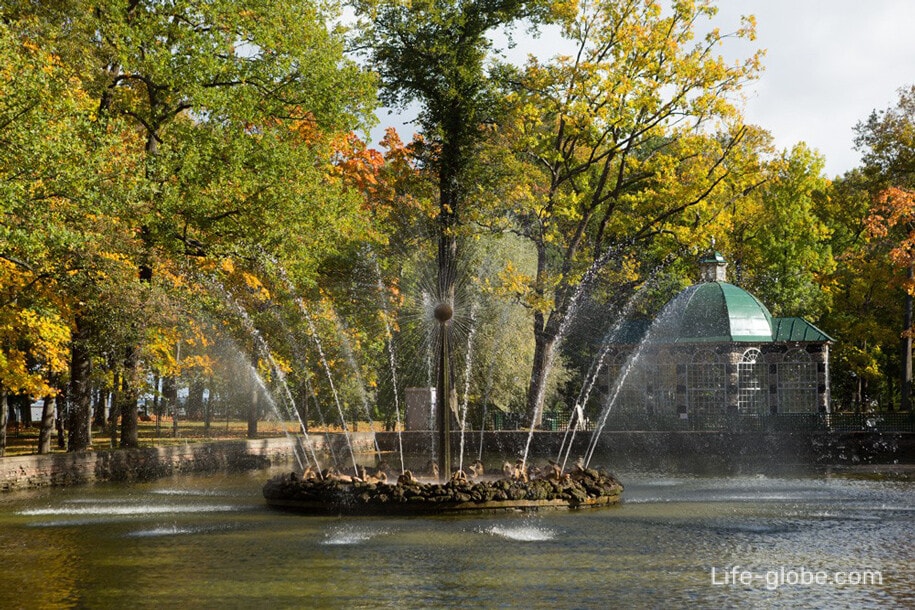
On the east and west sides of the fountain " Sun " there are two light wooden pavilions - Aviaries.
In these twelve-sided gazebos, crowned with domes and light lanterns, in the summer they hung cages with birds. The eastern Enclosure was home to parrots, while the western Enclosure was home to songbirds: nightingales, thrushes, finches, finches, and bullfinches.
Today, as before, the aviaries are home to birds, including parrots and swans.
Entrance is paid. The aviaries are open during the summer season.
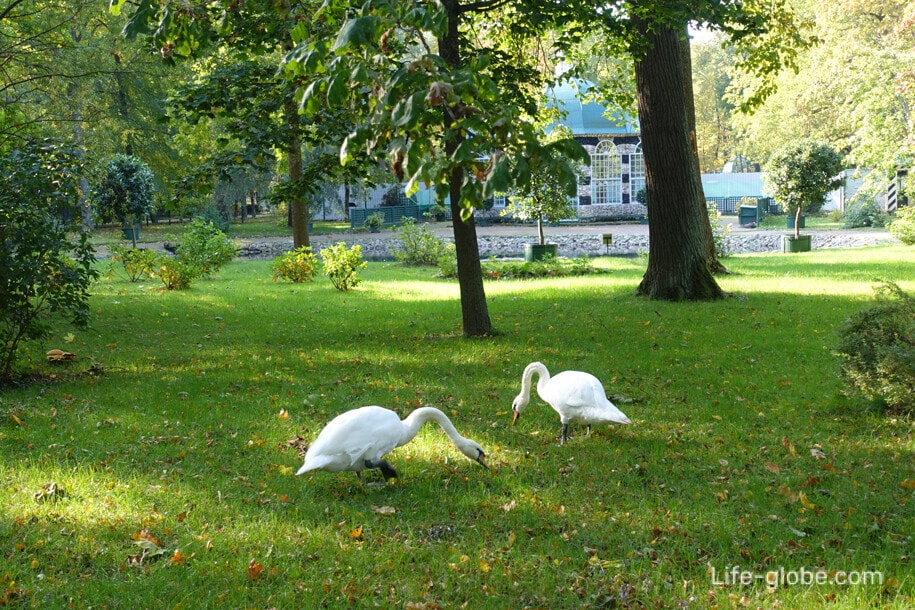
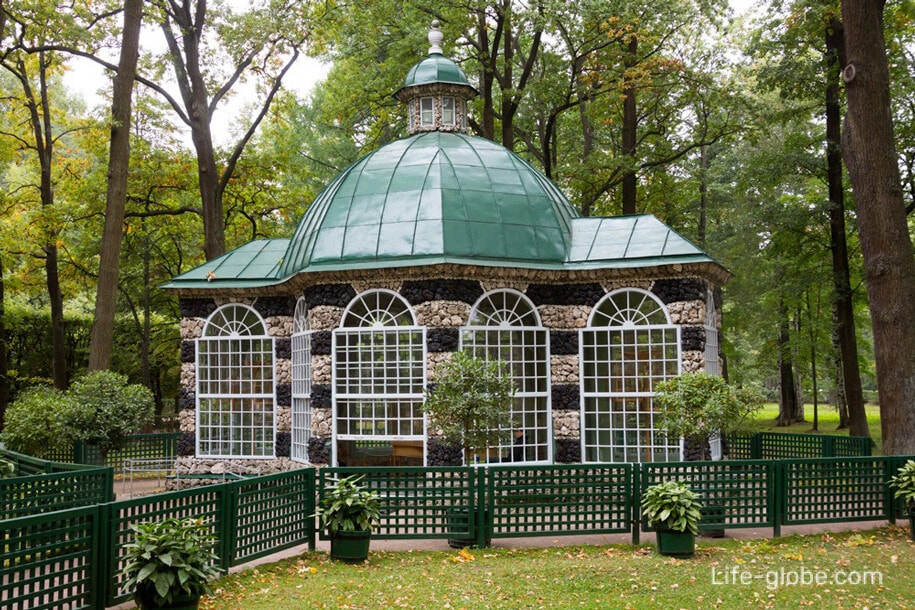
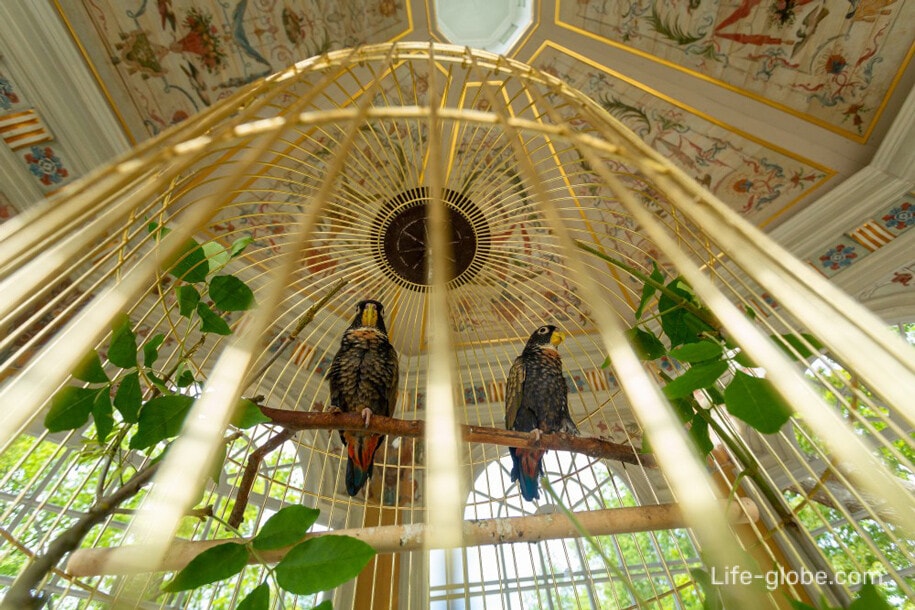
The Orangery Ensemble, which includes: the Big Orangery, the Orangery Garden and the Triton Fountain, also known as the Orangery Fountain.
Fruit trees, vegetables, and flowers were grown in the garden; in the center was a pool from which the gardeners took water for irrigation. In 1726, according to the plan of Peter I, the architect T. Usov decorated the pool with a fountain "Triton".
The sculptural group "Triton tearing the mouth of a sea monster", made according to the model of B.K. Rastrelli, represents an allegory of the triumph of Russia in the struggle for the Baltic Sea. Triton represents the young Russian fleet, which inflicted a decisive defeat on the Swedish squadron at Cape Gangut on July 27, 1714. The sea monster refers to the fleet of Charles XII. Four sculptures of a turtle in the fountain, which in fear seem to run in different directions, resemble the infidel allies of the Swedish king.
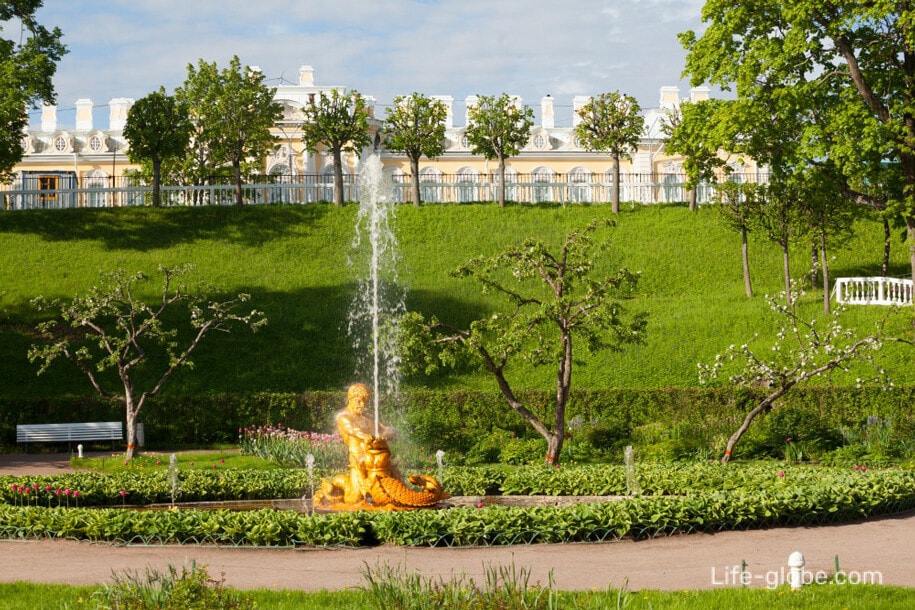
Fountains-firecrackers, which are allocated to a separate group of fountains in the Lower Park.
Fountain-firecracker-water fun, - a kind of hidden fountain with a comic surprise, disguised as familiar objects or hidden in the landscape, and the idea of which is that the water jets of the fountain appear unexpectedly and spray visitors, thereby creating a playful mood and immersing guests in the atmosphere of the game.
Fountains-firecrackers were one of the frequent elements of the ceremonial residences of the regular park style, including such fountains were created in the Lower Park under Peter I. The emperor liked to amuse himself by watching hidden fountains spray the expensive clothes of high-ranking and noble guests of the royal residence.
Only in the Lower Park are seven fountains, firecrackers, five of which (Tree, oak, Umbrella, Water, road and Sofas) are located near each other in the Eastern part of the Lower Park; and two fountain-crackers ("Table with sprinkling" and "Water curtain") - in the caves of the Grand cascade fountain in Central Park. Learn more about all the firecracker fountains in the Lower Park with photos and videos…
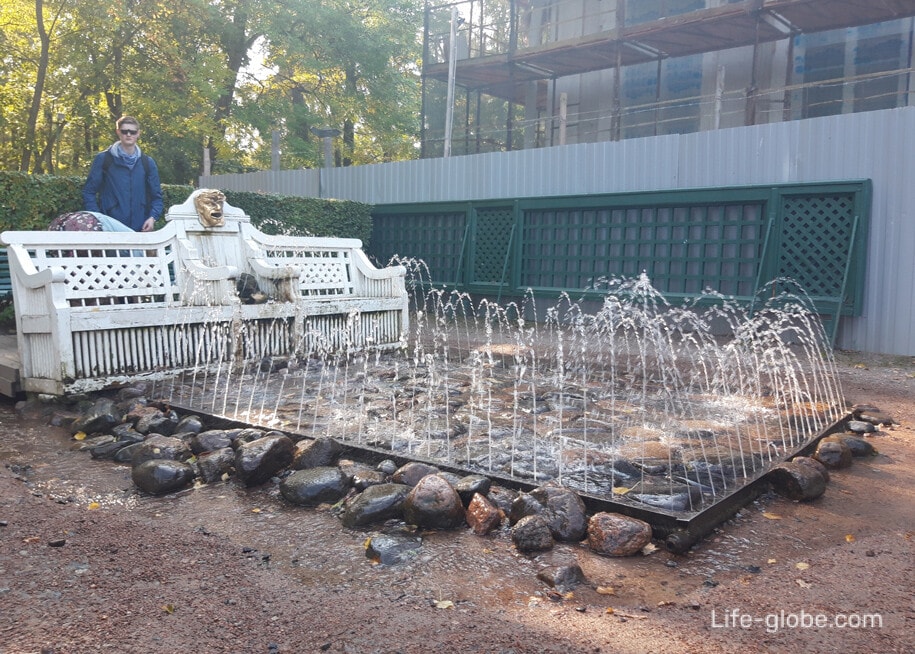
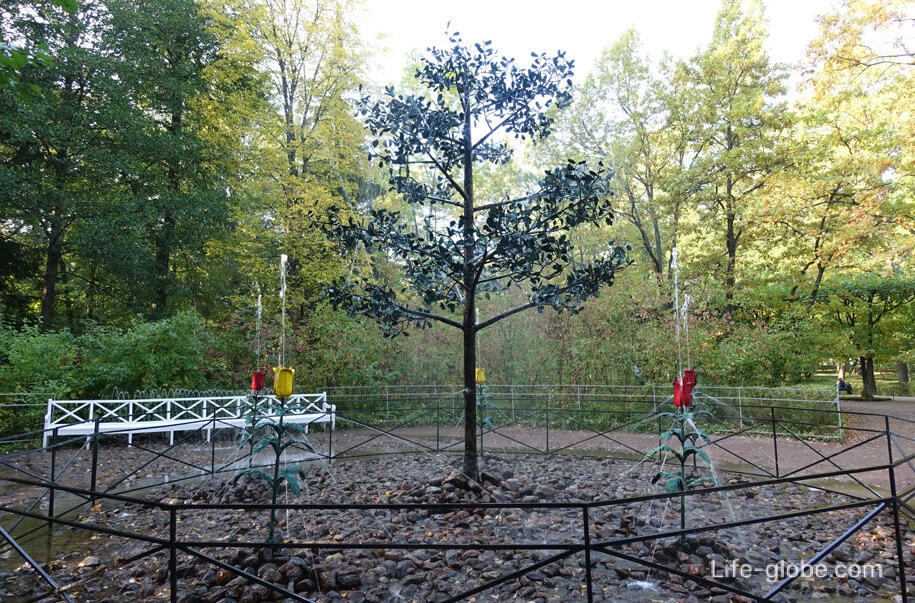
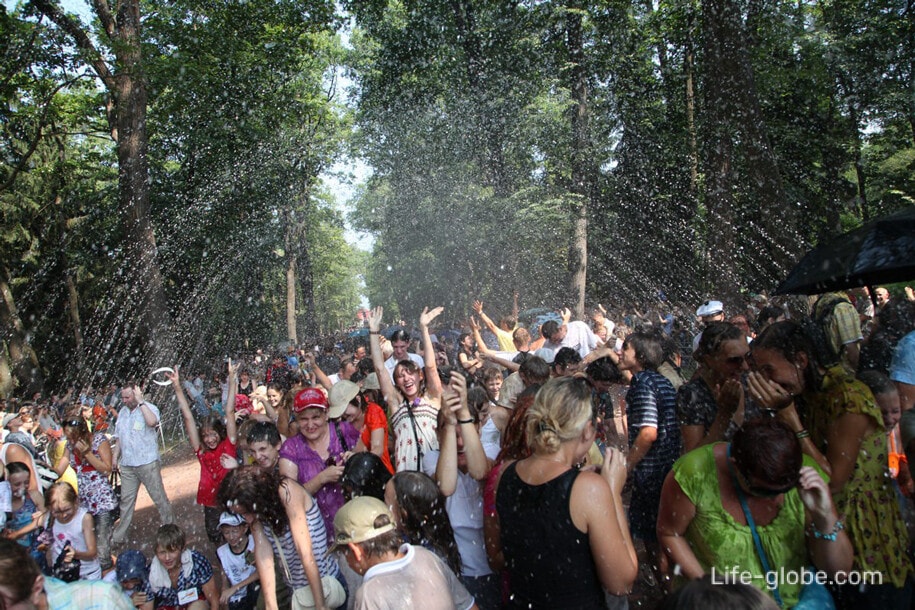
The Pyramid Fountain is one of the most powerful, beautiful and original fountains in the Lower Park of Peterhof.
In addition to beauty and power, the Pyramid fountain is considered the most water-rich, since it consumes about 100 liters of water in one second.
The fountain is a four-sided seven-stage pyramid, which is completely formed by 505 powerful water jets, which beat with such force that at first glance you can not even imagine that the obelisk consists entirely of water. Learn more about the Pyramid fountain with photos and videos…
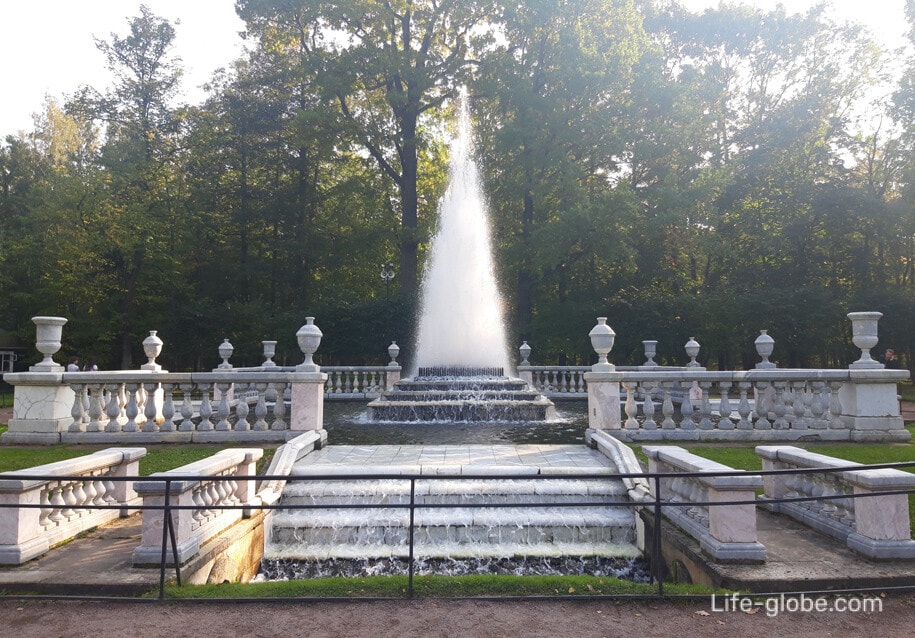
Completes the eastern part of the Lower ParkA maze with a fountain.
The labyrinth was created in the first quarter of the 18th century by order of Peter the Great. In the plan, it is a rectangular area with an oval platform in the center, from which eight small alleys diverge, the space between which is formed by bosquettes.
All the paths and borders of the maze are framed by trellises made of bush lime trees growing along the wooden trellises. In the bosquets, apple trees are planted and small areas with niches for garden benches are arranged.
In the center of the maze is a swimming pool with a fountain of the menagerie type, which appeared in this place in the middle of the 18th century, according to the plan of the new decorative decoration of the Maze created by F. B. Rastrelli.
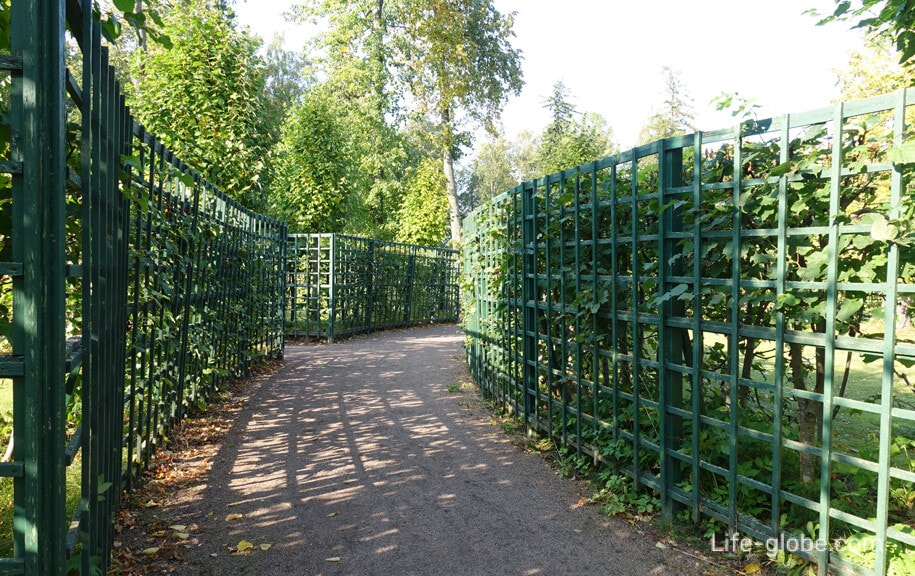
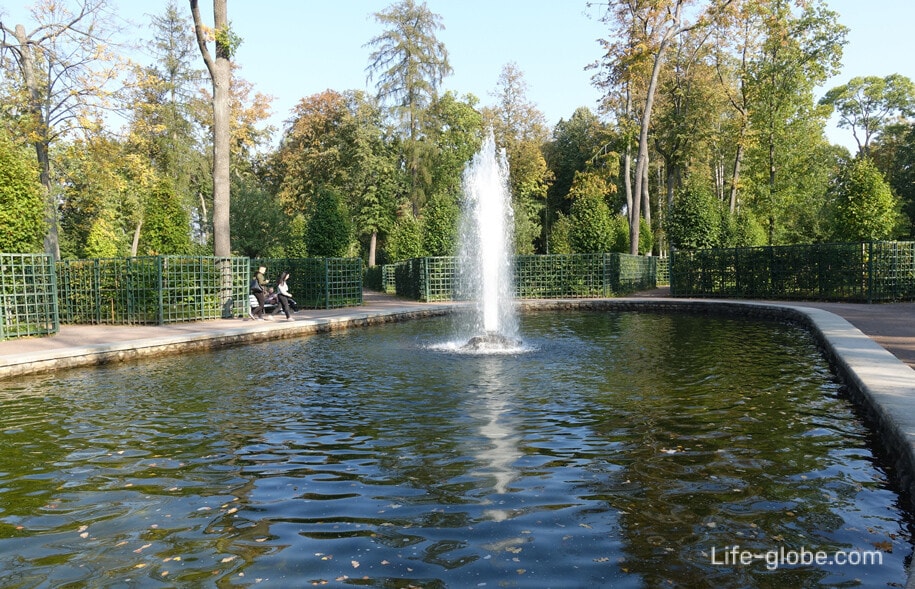
The eastern end of the Lower Park borders the park of Alexandria, which has 115 hectares. and named after its first owner-the Empress Alexandra Feodorovna (wife of Emperor Nicholas I).
Entrance to the park is paid.
You can visit the park on your own or from the square in the Lower Park, where the Roman Fountains are located, on an excursion train with an audio guide.
Tickets can be purchased here - at the ticket office. The cost of a full adult ticket is 400 rubles, children under 3 years old-free of charge.

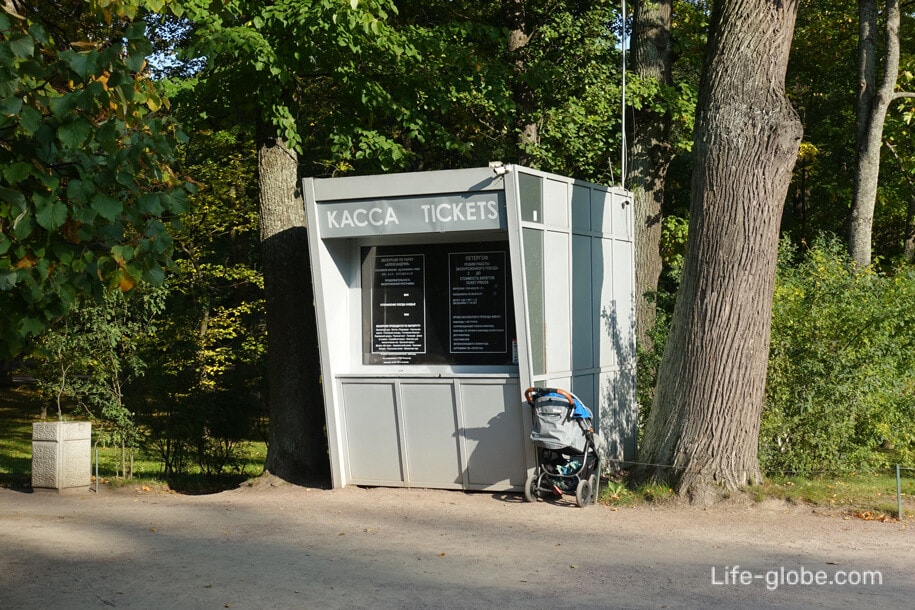
The route of the excursion train from the Lower Park to the park of Alexandria
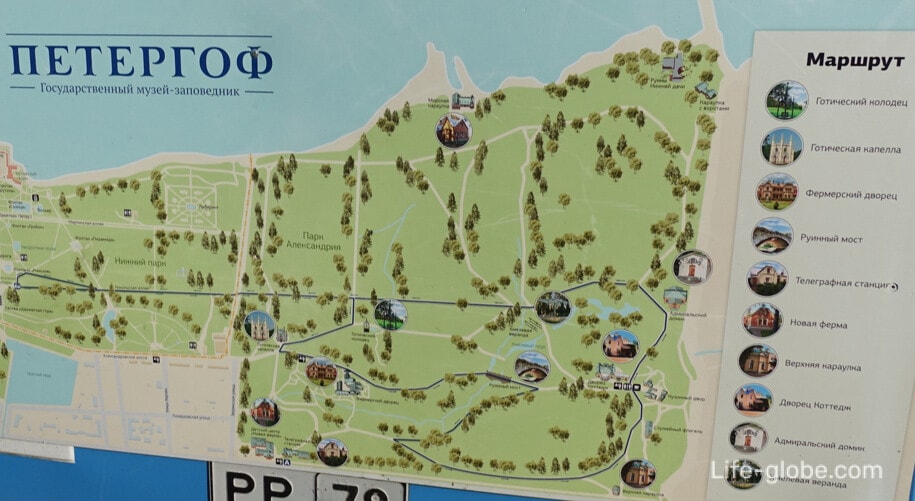
The Lower Park of the Palace and Park Ensemble "Peterhof" belongs to the State Museum-Reserve "Peterhof".
The fountains of Peterhof are closed for the winter (do not work) - from about the middle of October until the 20th of April.
In winter, when the fountains are not working, the entrance to the Lower Park is free (free of charge).
During the summer season, the fountains are open and the entrance to the park is paid.
Entrance to each of the park's museums is paid. Museum visits are not included in the price of the entrance to the Lower Park - they are paid separately.
The park's museums can be closed for the winter, open only on certain days that change depending on the season (summer, winter), and also stop working under certain weather conditions.
Tickets to the park and museums can be purchased at the ticket offices located directly near the entrances to the park or in advance-online on the official website.
We recommend that you check the opening hours of the park and museums, as well as the conditions for visiting and the cost of tickets, on the website of the State Museum-Reserve "Peterhof": peterhofmuseum.
You can visit Peterhof with one of the excursions
All the ways to get to Peterhof from St. Petersburg (the airport and the city center) can be found here →
Near the Palace and Park Ensemble "Peterhof" you can stop
The 4-star Novy Peterhof Hotel features a restaurant, a bar, parking, a tour desk, a spa area with an indoor pool, a gym, a steam bath, a Finnish cedar sauna and an aroma sauna.
The rooms are decorated in a modern style and feature a TV with satellite channels, free Wi-Fi, a safe, bathrobes and slippers, a hairdryer and free toiletries. Some rooms have a seating area.
The room rate can include: breakfast, breakfast + dinner or breakfast + lunch + dinner. Link to the hotel
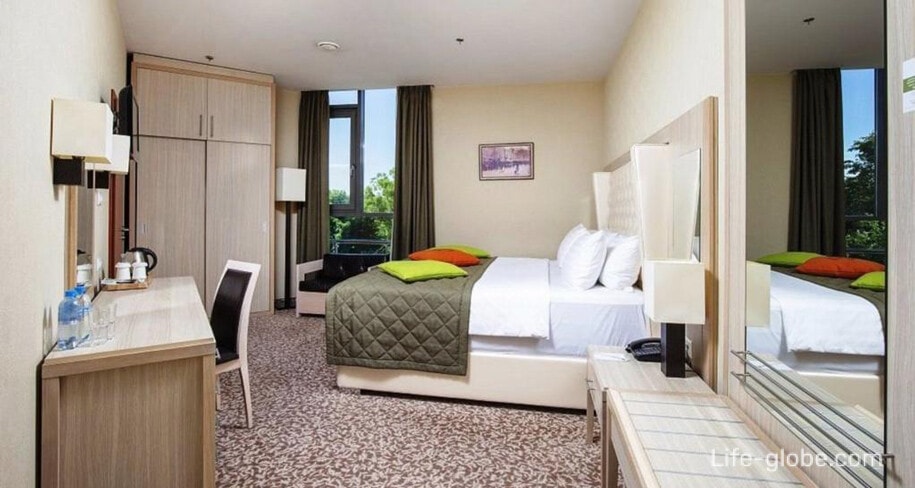
EGO-LOFT Apartment (Holgin Pond) they offer views of the lake and the city.
The apartmentfeatures air conditioning, a balcony, free Wi-Fi, a flat-screen TV, a washing machine, a bedroom, a kitchen with a dishwasher and a microwave, and a bathroom with a hairdryer and free toiletries. Link to the apartment
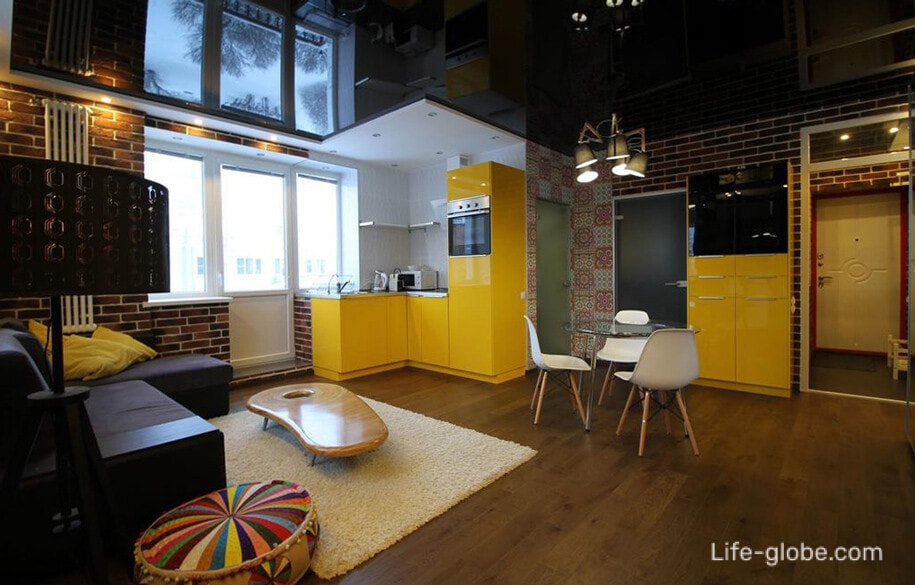
Severnaya Venezia Apartment с features a balcony with lake views, free Wi-Fi, a children's playground, a garden and a shared lounge.
The apartmentfeatures a bedroom, a flat-screen TV with cable channels, an equipped kitchen with a microwave and a refrigerator, a washing machine, and a bathroom with a shower. Link to the apartment
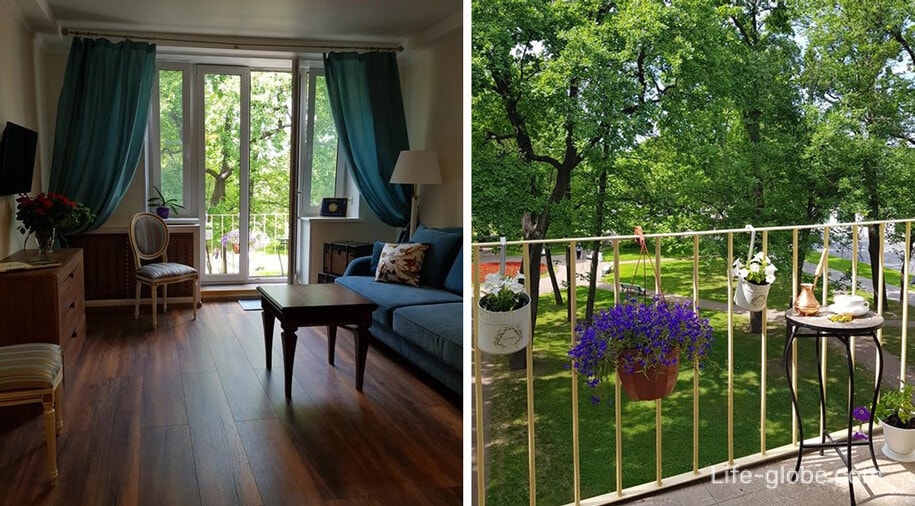
All accommodation facilities in St. Petersburg, including in the city center and in Peterhof, can be viewed and booked here